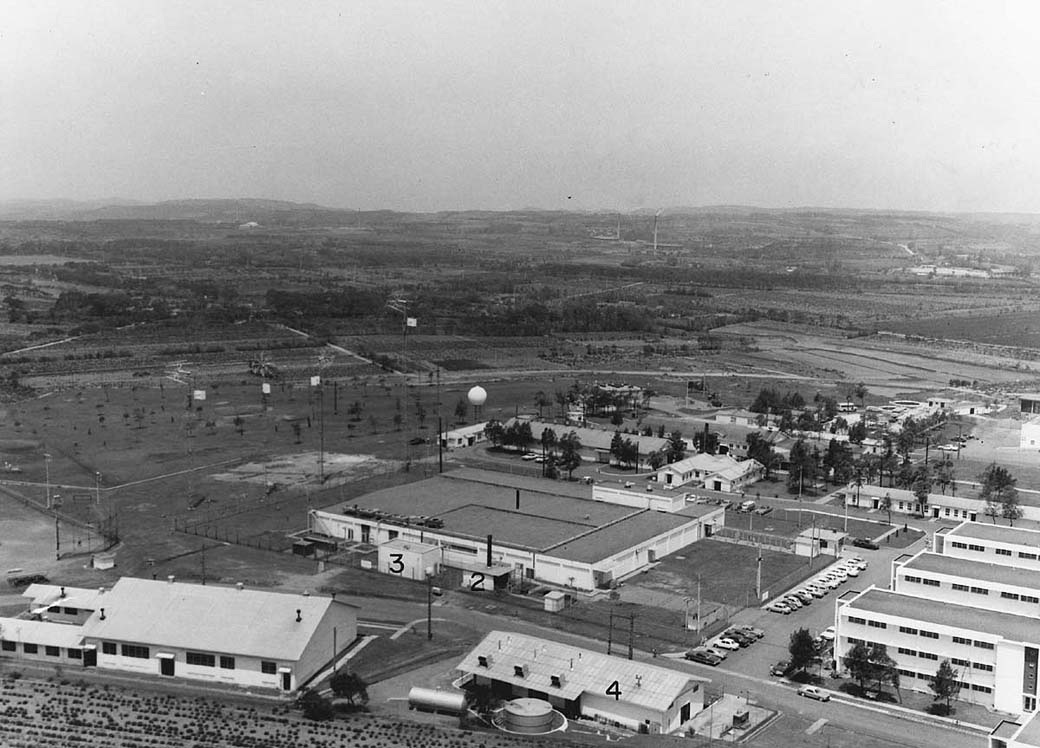
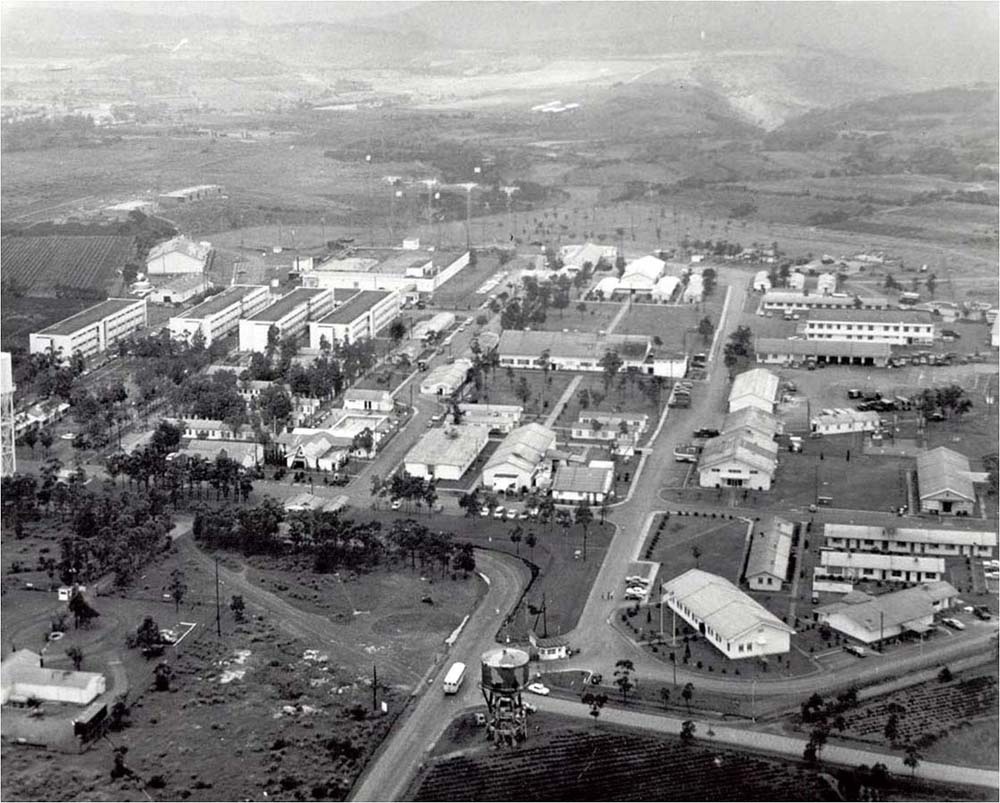
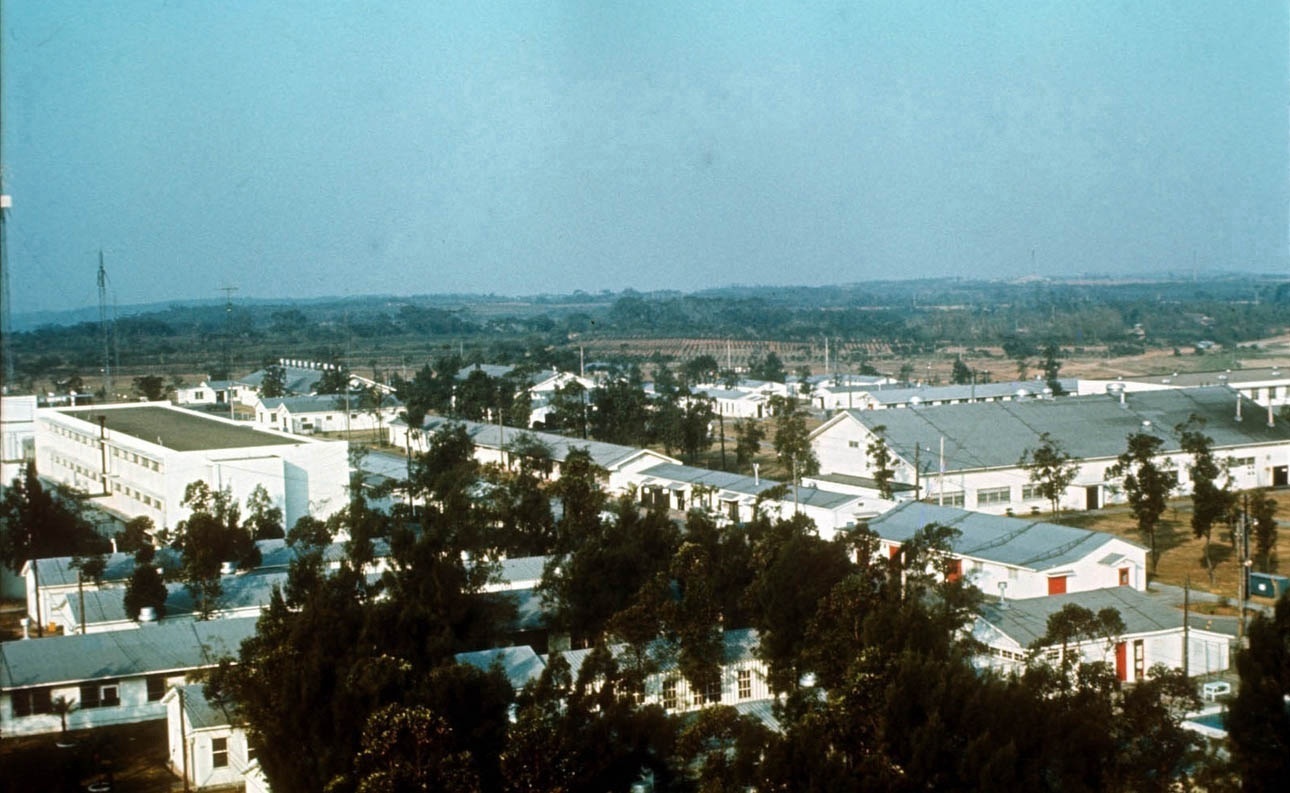
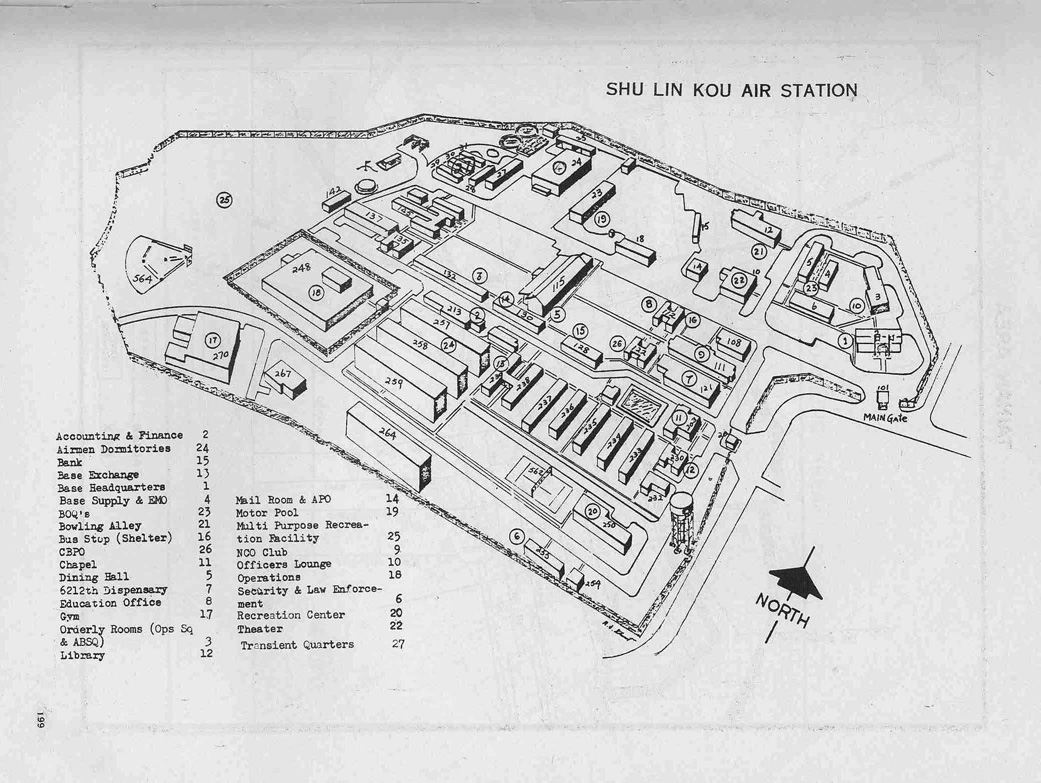




(1.) (Foreground-from left) Ball Field (far left), rear of Gymnasium and Power Plant (bldg. no. 4 in photo). (Center of Photo) (bldg. no. 1 in photo) Operations Center building, burn-bag incinerator in compound (bldg. no. 2 in photo), storage shed in compound (bldg. no. 3 in photo), Air Force Dormitories (far right), and Navy Dormitory (lower right corner). (Background-from left) Antenna Field, Golf Course, Antenna Maintenance building, Civil Engineering (buildings 135, 137, and 145), HSS Office/Orderly Rooms (long bldg.-right background).
(2.) 1970 aerial photo of Shulinkou Air Station. The Dragon Inn Dining Hall is in the center of the photo (large bldg). The base Gymnasium, Ball Field, and Operations Center are in the upper left. The Main Gate and old Water Tower are in the lower center foreground. Headquarters, BOQ, and Officers' Club are in the lower right. The Linkou Club offices (on corner), Linkou Club, Dispensary, Chapel (Pool behind), and Library are the first five buildings (respectively) on the first street on the left beyond the Main Gate. The Theater (large bldg) is on the corner on the first street on the right beyond the Main Gate and Headquarters. Linkou Lanes Bowling Alley is to the right of the Theater. The Fire Department is behind the Theater (a parked fire truck is visible).
(3.) 1970 aerial photo of Shulinkou Air Station. Shown are the Dragon Inn Dining Hall (far right), WAF Dormitory (left), and Operations Center (far left). The Credit Union and Bank, and the Snack Bar and Mail Room were located (respectively) in the first two buildings just to the left of the Dragon Inn. The Linkou BX was located in the long building (left foreground) closest to the Dormitory.
(4.) Annotated base map/diagram of Shulinkou Air Station in 1970.
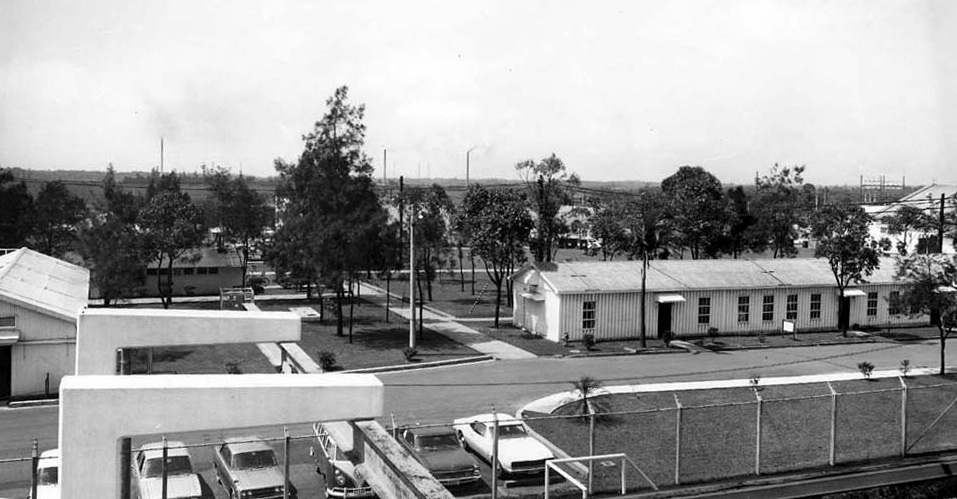
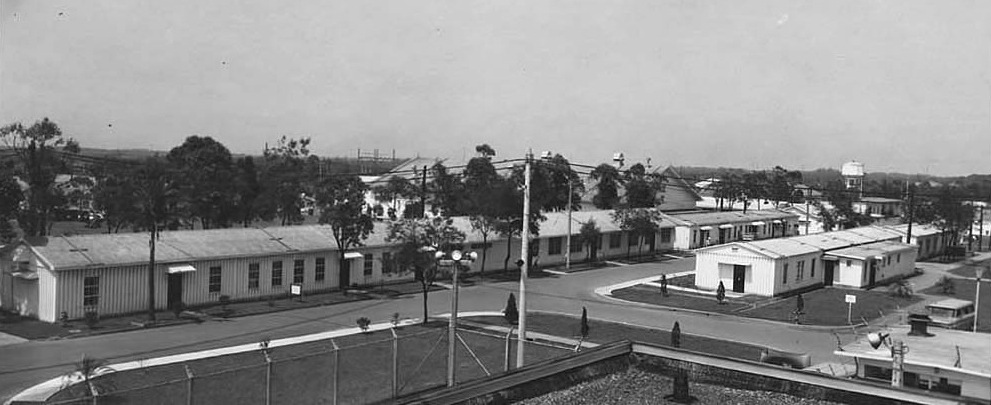
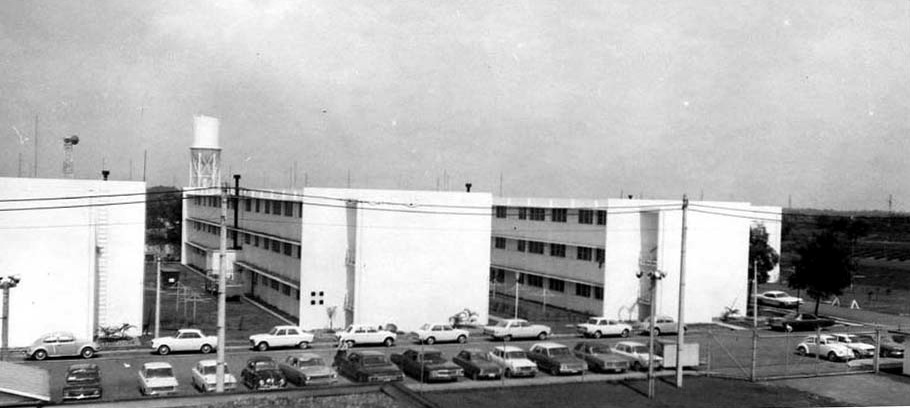
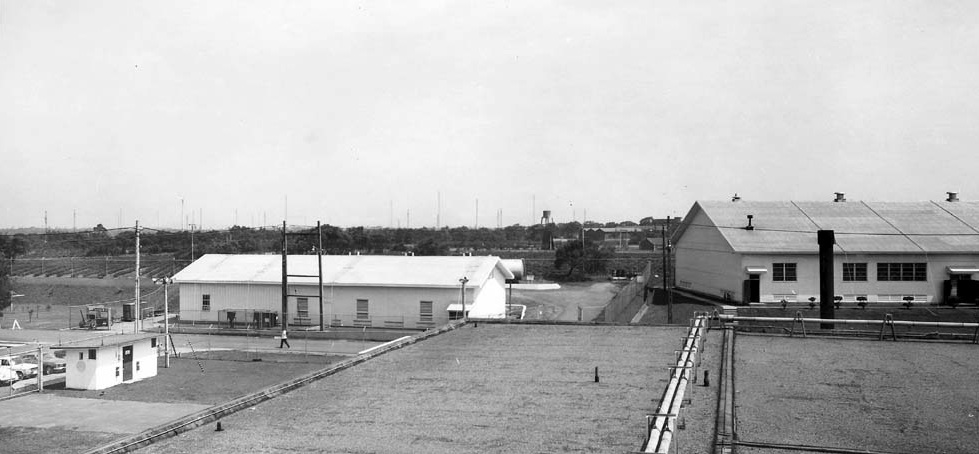
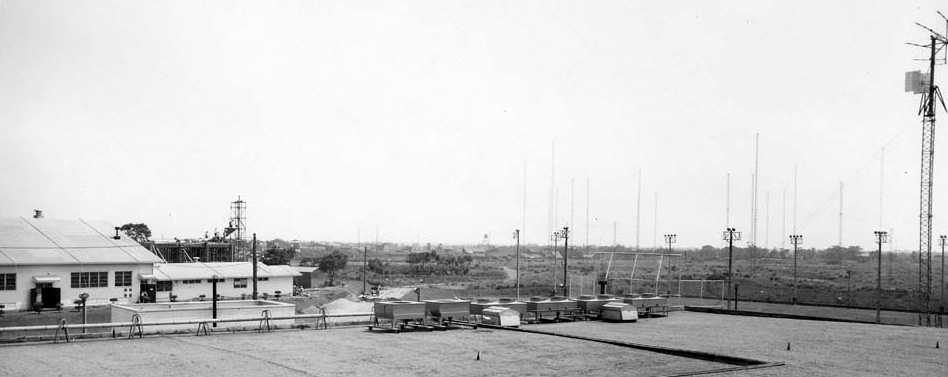
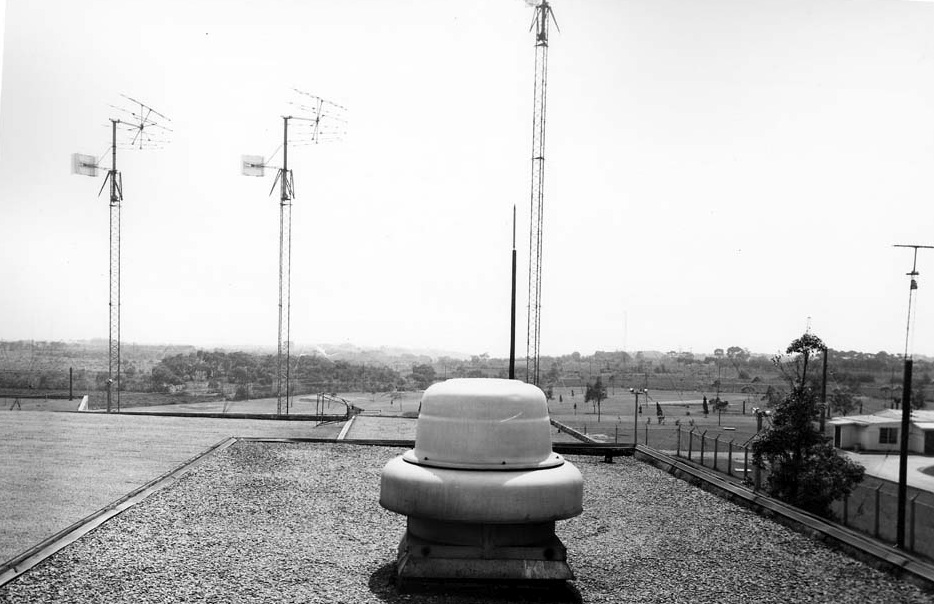
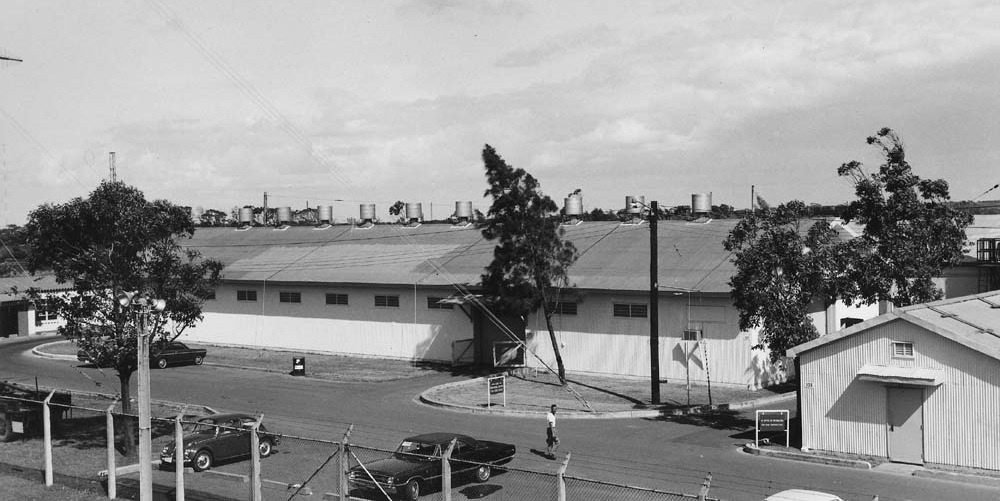
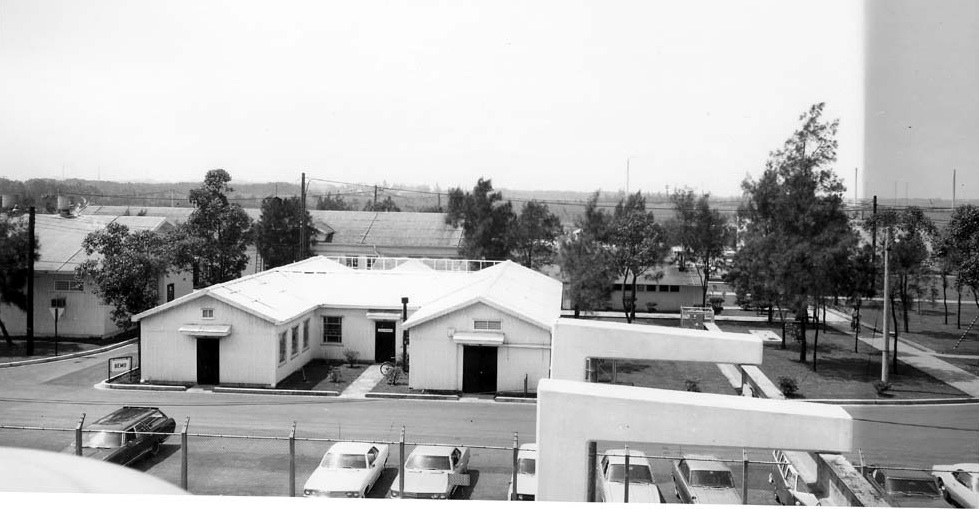
(Top Row) View from left to right from Ops Center roof:
(1.) Looking north (left side of Ops Bldg): Civil Engineering (bldg 135-far left) and Orderly Rooms (right). (2.) Looking northeast (left front of Ops Bldg): Orderly Rooms (long bldg on left), Dragon Inn Dining Hall (left background), and old water tower located off base at Main Gate (right background). (3.) Looking east (front of Ops Bldg): Dormitories, and base Water Tower. (4.) Looking south (right side of Ops Bldg): Power Plant (bldg 267) and Gymnasium (far right). (Circa 1970 photos)
(Bottom Row) View from left to right from Ops Center roof:
(1.) Looking south (right side of Ops Bldg): Gymnasium (far left) and Ball Field (overhead lighting). (2.) looking west: antennas behind Ops Bldg. (3.) Looking northwest (left rear of Ops Bldg): Civil Engineering (bldgs 137 and bldg 135-far right), which housed several shops, carpenters, plumbing, electrical, and HVAC. (4.) Looking north (left side of Ops Bldg). Shown are the three base Civil Engineering buildings: (center foreground) Bldg 135 housed the drafting section (sign in front reads BEMO), (far left) Bldg 137 (see previous photo), and the large Civil Engineering headquarters building (Bldg 145-roof visible in background). (Circa 1970 photos)
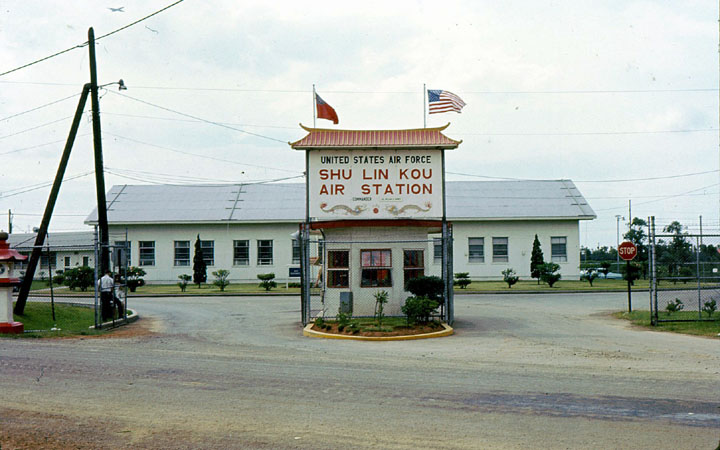
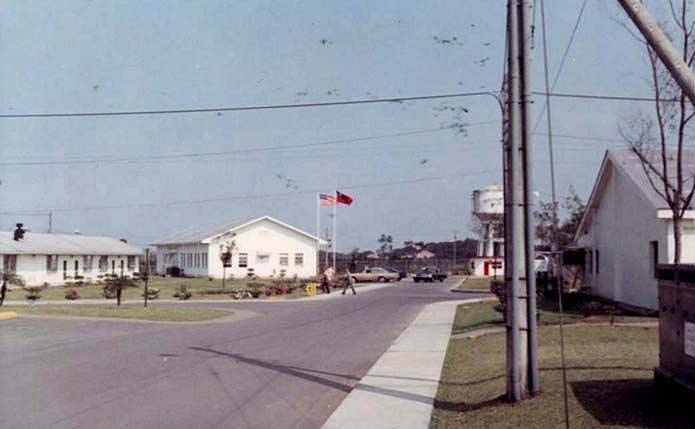
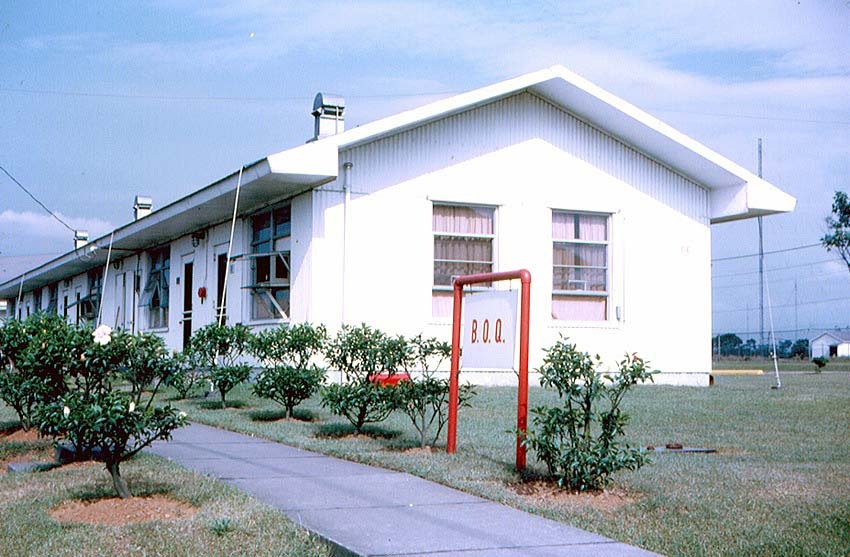
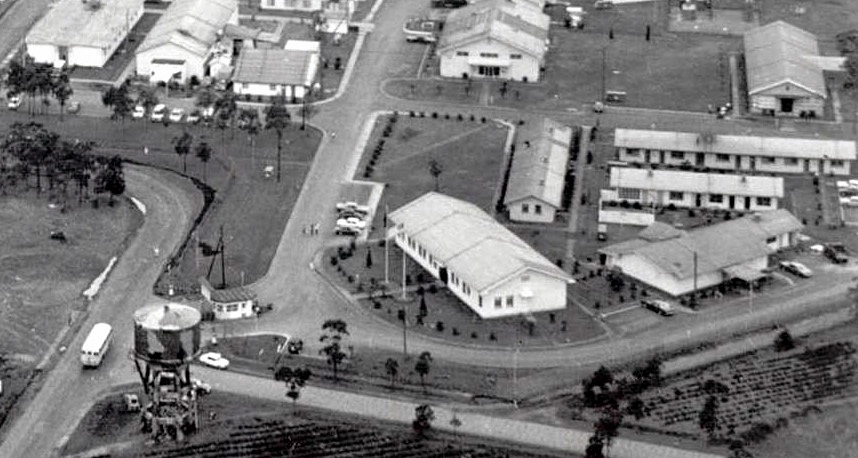
(1.) 1970 shot of the Main Gate, Guard Shack, Headquarters, and "BOQ" (Bachelor Officers' Quarters) on the far left. Col William B. Barnes was base commander (27 Jun 69-27 Jun 71).
(2.) 1970 shot looking east from the Bus Stop are the Bachelor Officer's Quarters (far left), Headquarters (flags), Main Gate and old water tower off base. Linkou Club's administrative building (far right) was located next door to the club (off to the right). The Theater and Fire Dept. are off to the left of the photo.
(3.) 1967 shot of the Bachelor Officers' Quarters ("BOQ"). The "BOQ" on base consisted of three buildings adjacent to Headquarters and the Officers' Club (see next photo). The "BOQ" had single rooms with bathrooms and private entrances.
(4.) Cropped enlargement of the 1970 aerial photo at top of page showing: (Top of Photo on left, L-R): Dispensary, Linkou Club, Linkou Club administrative offices (on corner), and Theater and Bowling Alley located on "Lantern Loop".
(Bottom of photo on left, L-R): Old Water Tower (off base), Main Gate, Headquarters, BOQ (three narrow bldgs), and Officers' Club (large bldg-cars in front), which was located on the street, "Lantern Loop".
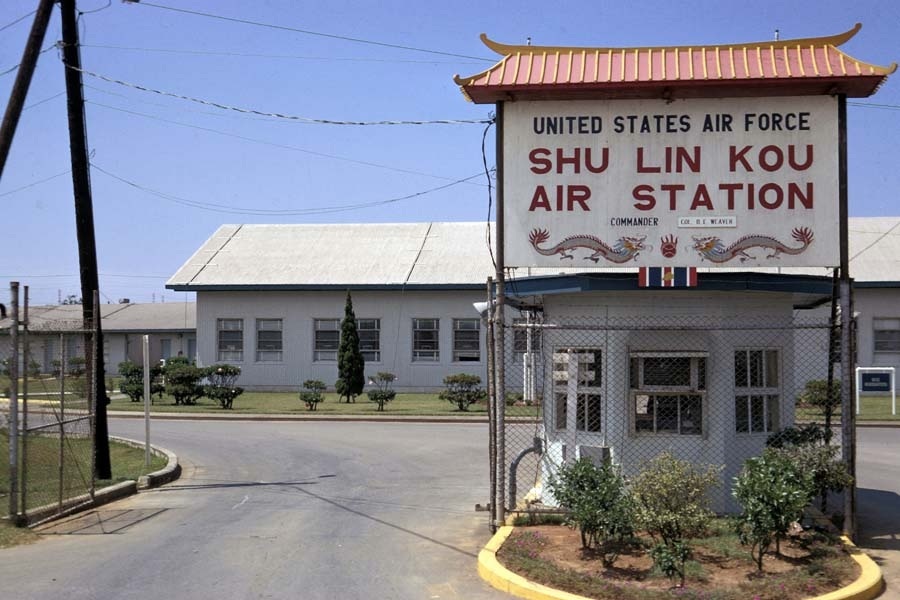
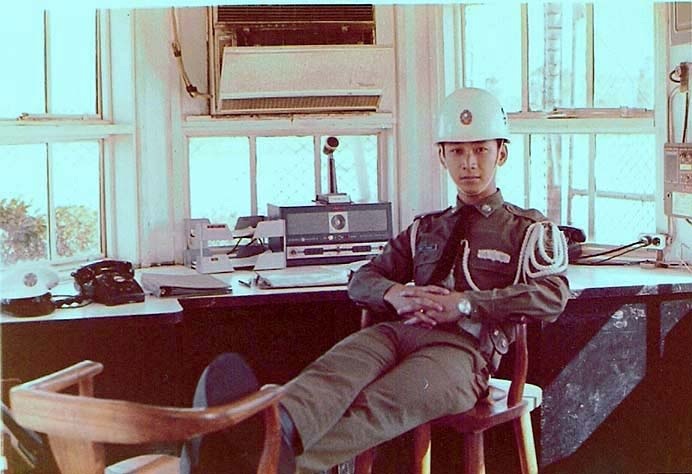
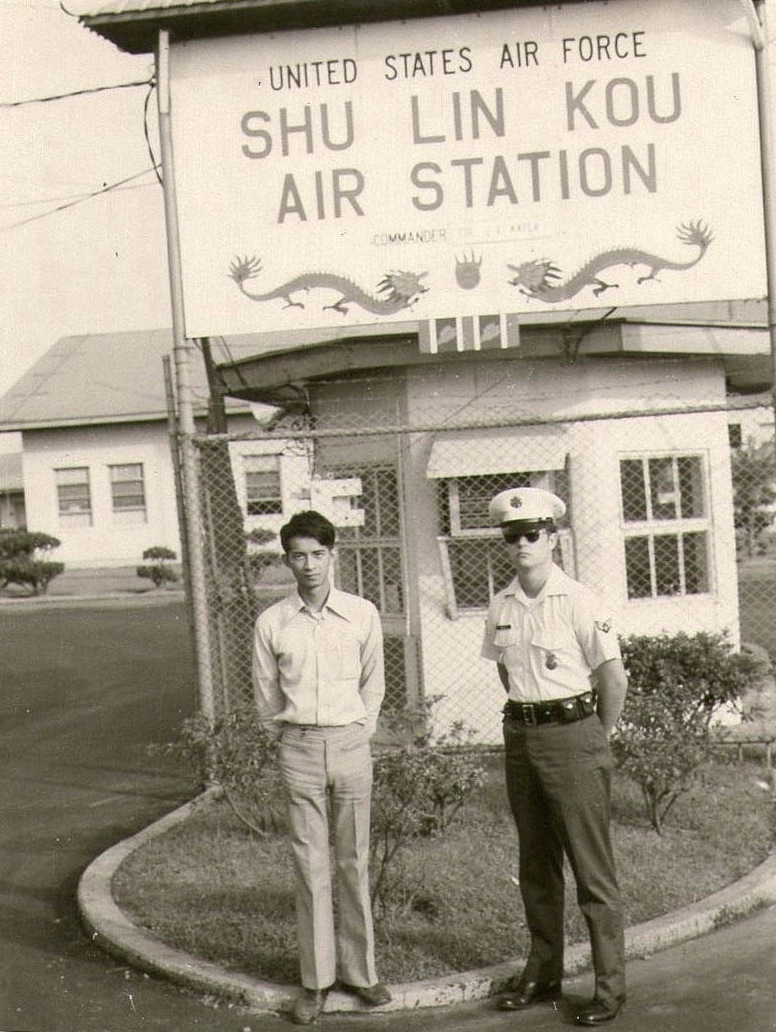
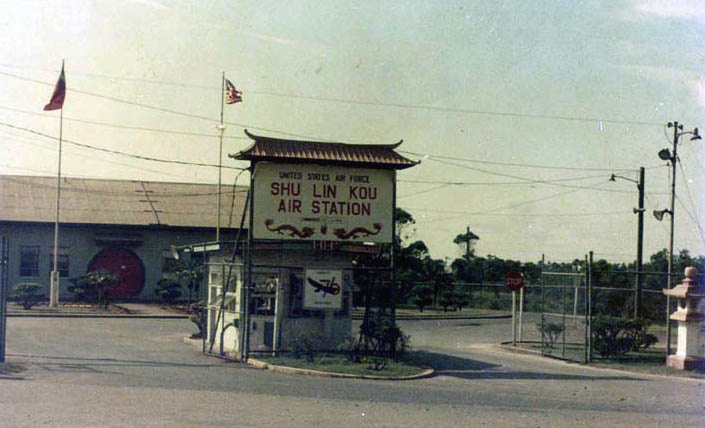
(1.) 1973 shot of Main Gate, Headquarters, and BOQ (far left). Col. Donald E. Weaver (name on Guard Shack sign) was base commander (20 Jun 73-Sep 74). He replaced Col. O.D. Graham (28 Jun 71-19 Jun 73). Col. Weaver was a captain while previously stationed at Linkou in 1957.
(2.) 1973 shot of a ROC military policeman (MP), inside the Guard Shack at the Shulinkou Main Gate.
(3.) 1976 photo of Wen Hsiao, ROC foreign affairs military policeman (MP), and Sgt. Gary Smith, USAF Security Police, outside the main gate. Headquarters and the BOQ (far left) are in the background. Colonel James E. Kater (name on Gate Shack sign) was the base commander in 1976 (tour dates unavailable).
(4.) July 1976 shot of the Main Gate, Guard Shack, and Headquarters. The "76" and eagle placard below the "Shu Lin Kou Air Station" sign on the Guard Shack signified the 1976 Bicentennial celebration in the states commemorating the 200th year anniversary of the founding of the United States.
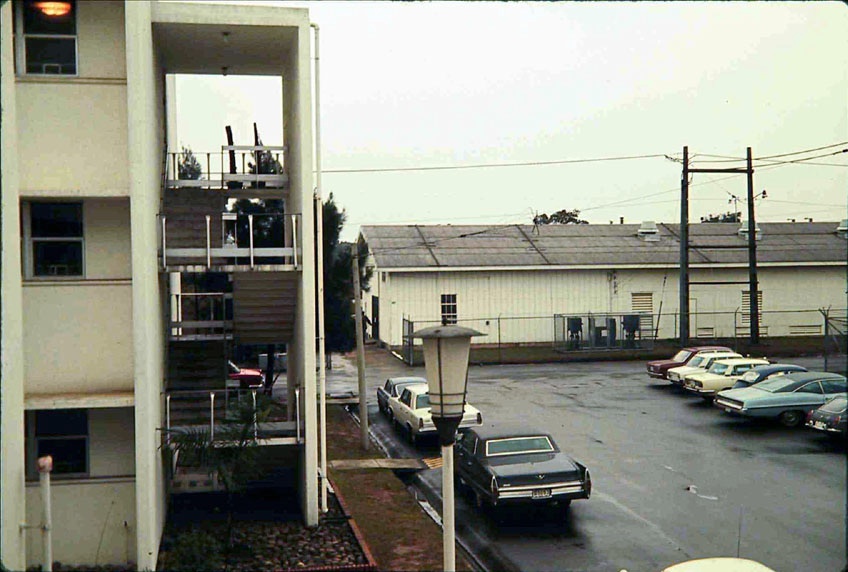
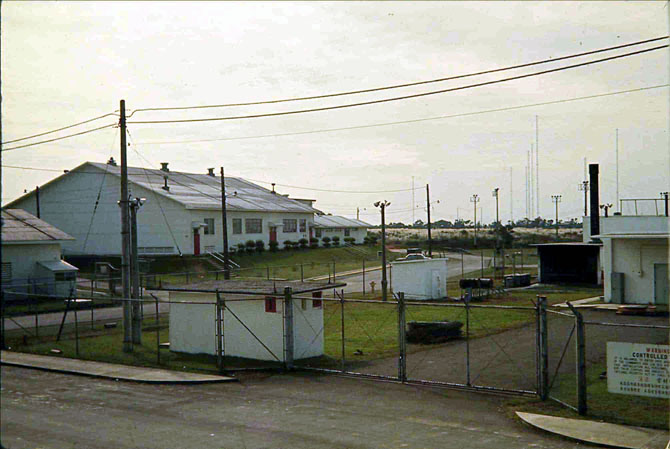
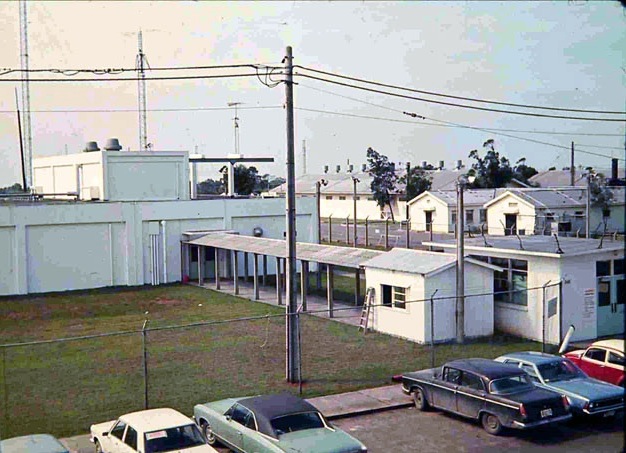
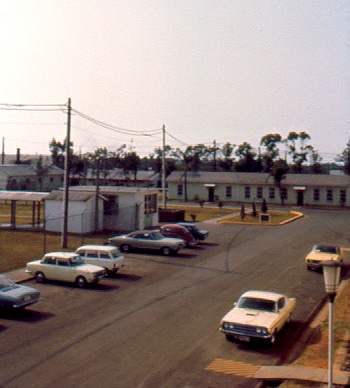
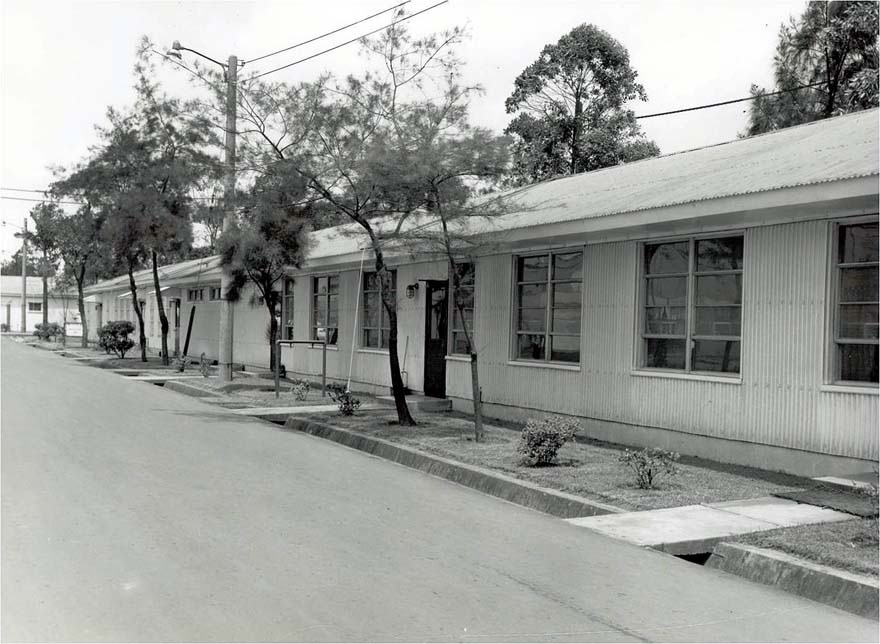
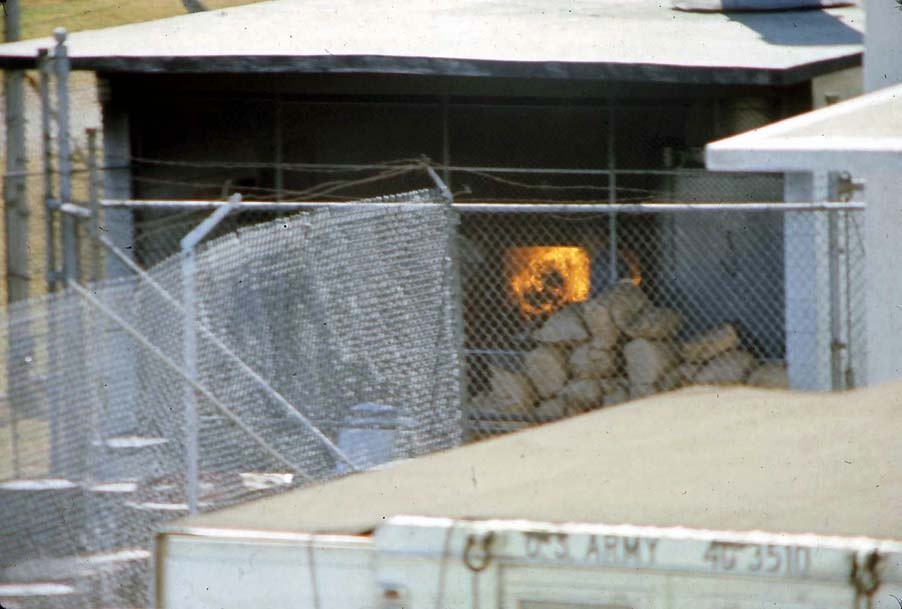 Four 1970 sequential panoramic shots looking from the far left to far right from Dawg Flight's second floor barracks stairwell landing.
Four 1970 sequential panoramic shots looking from the far left to far right from Dawg Flight's second floor barracks stairwell landing.
(1.) 1970 shot looking far left from the Dawg Flight barracks is the stairwell of the Able Flight barracks (2nd floor) with E-6s and above on the first floor, and the "Day Ladies" on the third. The base Power Plant is the on the right (bldg. 257). The Ops Compound and Gym are just of to the right.
(2.) Second sequential shot looking left from the Dawg Flight barracks front stairwell. (From left) base Power Plant, Gymnasium, Ball Field (overhead lighting visible), Operations Compound and black "burn-bag" incinerator (black smokestack), and Operations Center building (far right). (1970 photo)
(3.) Third sequential shot of the Compound, Guard Shack, and Operations Center building entrance. Civil Engineering are the buildings in the right background (bldgs. 135, 137, & 145 on the base map at top of page). (1970 photo)
(4.) Fourth 1970 shot looking to the right of the Guard Shack and HSS Office/Orderly Rooms (long bldg. in background-see next photo).
(5.) HSS Office/Orderly Rooms May 1969 (shown in previous photo). The Operations Center building is off to the left of the photo.
(Right Photo) 1970 telephoto shot of "burn-bags" stacked and burning in the Operations Center incinerator located in the Operations Compound (see photo 2. above).
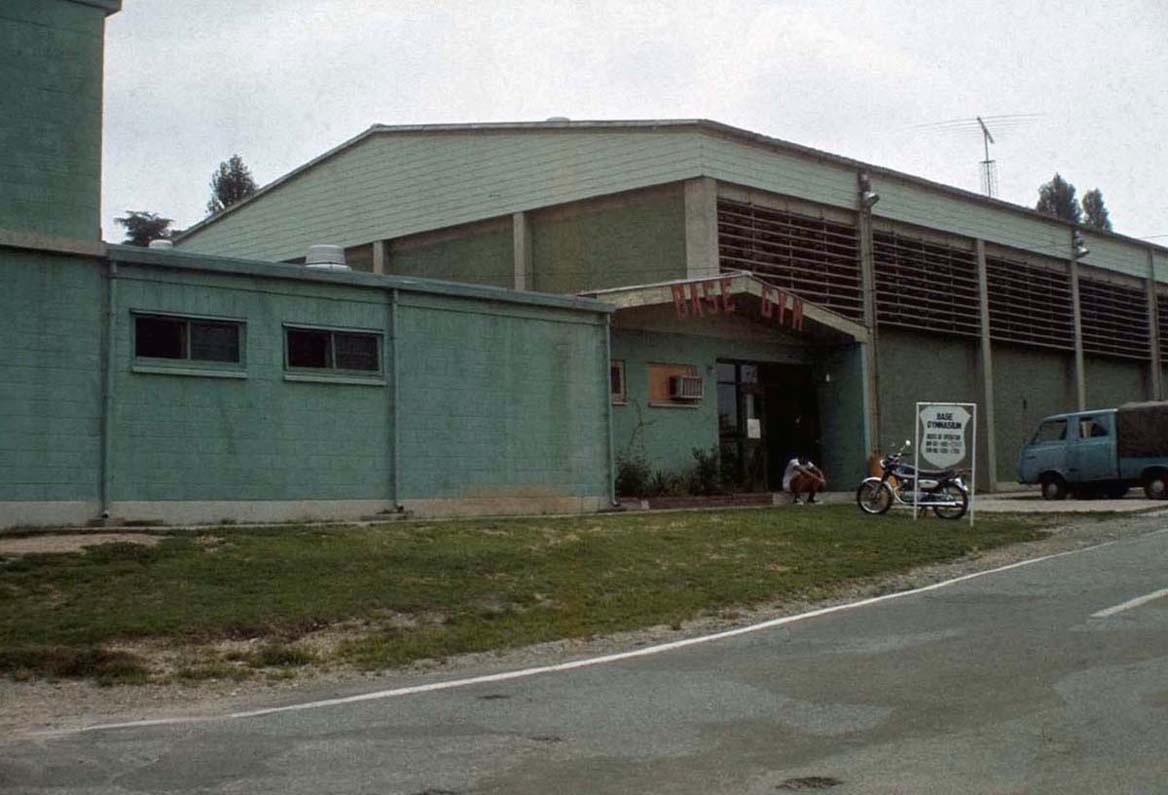
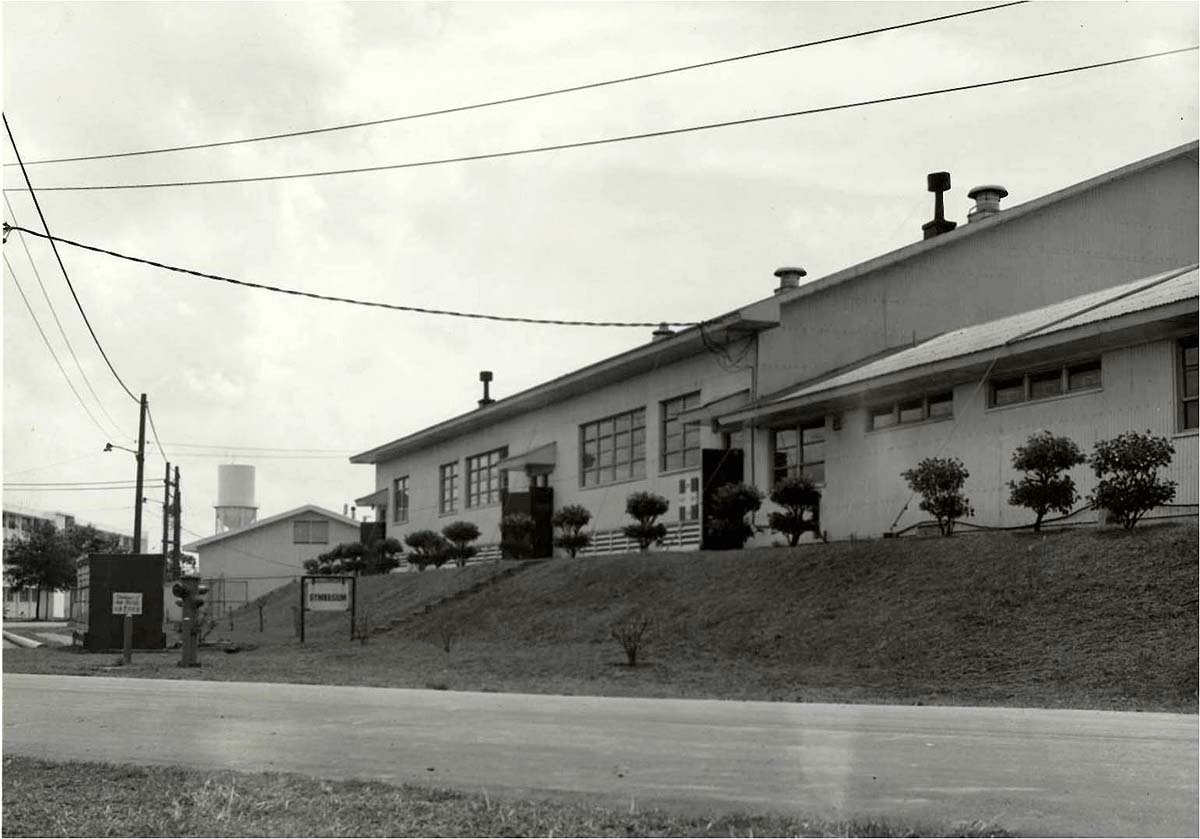
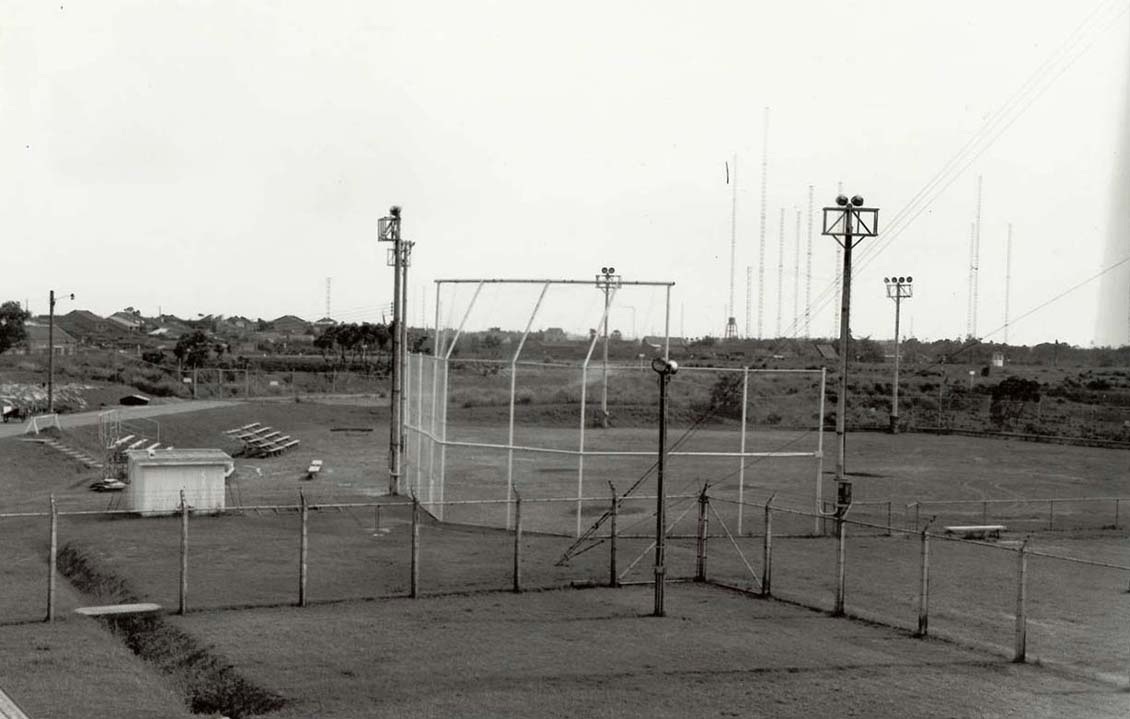
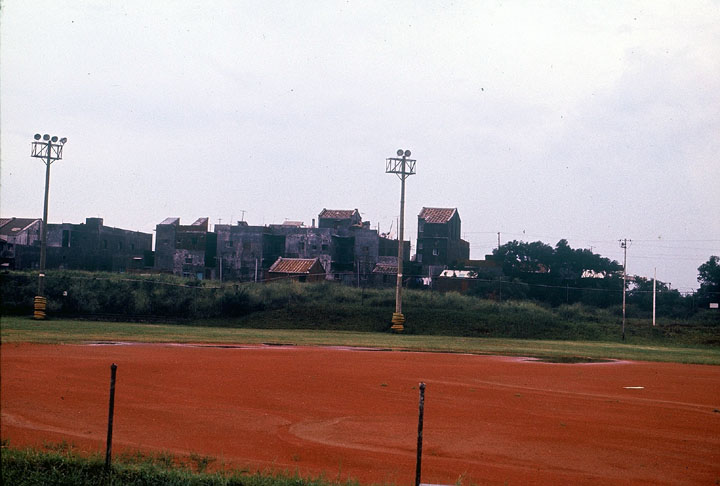
(1.) May 1969 shot of the Base Gym. The large Gymnasium had a regulation basketball court, equipment check-out room, handball courts, weight room, showers, and two sauna baths. The sign in front reads "HOURS OF OPERATION, MON-SAT-1000-2330, SUN-HOL-1000-1700. The adjacent Ball Field is off to the right of the photo.
(2.) May 1969 shot of Gymnasium. The Ball Field is off to the right of the photo. Shown in the background are the Barracks (far left), base Water Tower (background), and the base Power Plant just beyond the gym.
(3.) May 1969 shot of the Linkou Ball Field where softball and flag football games were played on the Hill. The Gymnasium is just off to the left of the photo. Shown in the foreground is the fenced left rear corner of the Operations Compound.
(4.) 1973/74 photo of the Linkou Ball Field. The new buildings shown behind the base's perimeter fence weren't there just a few years earlier in 1970/71.

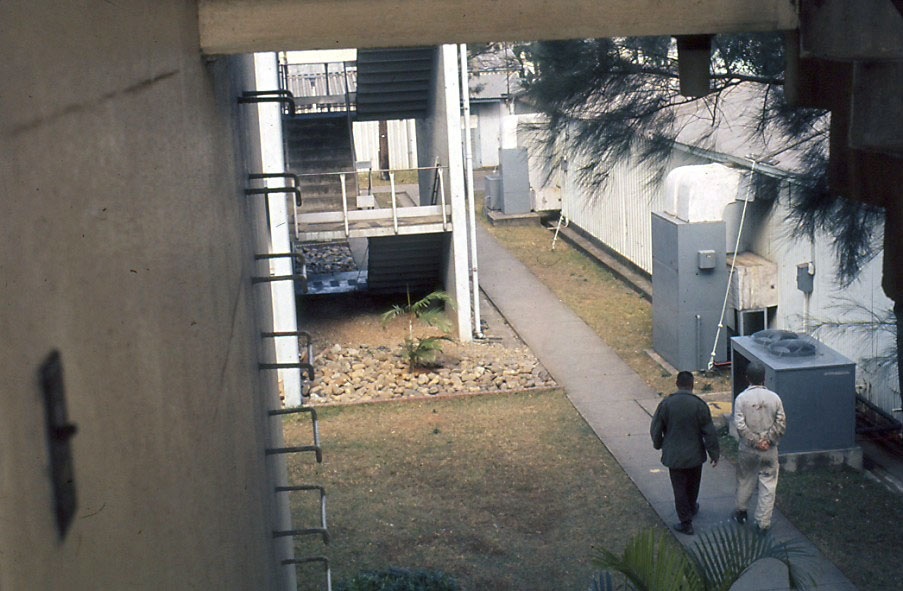
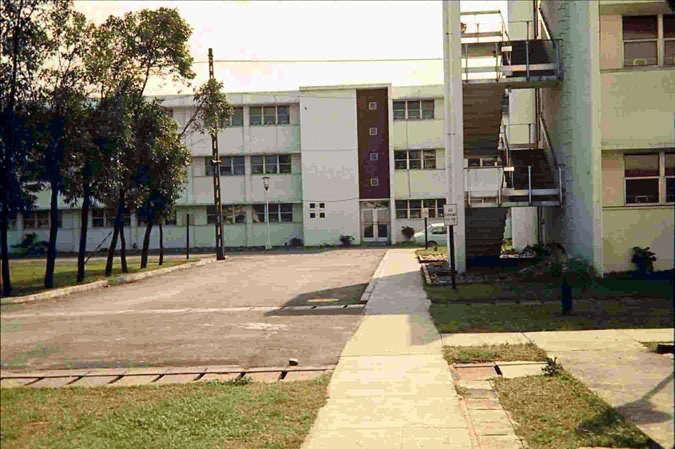
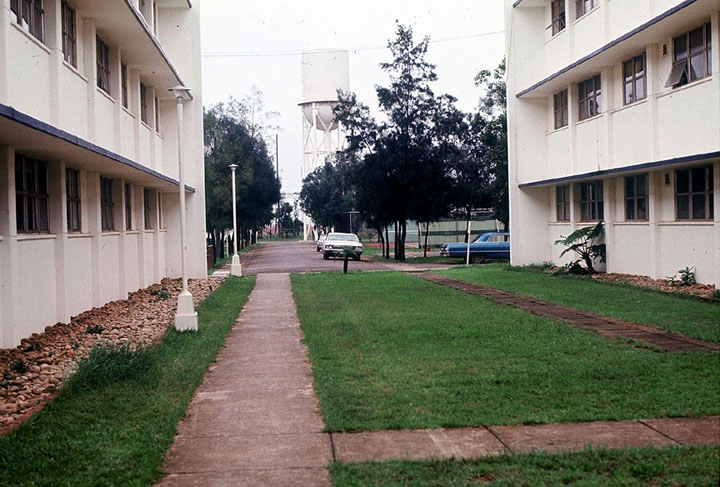
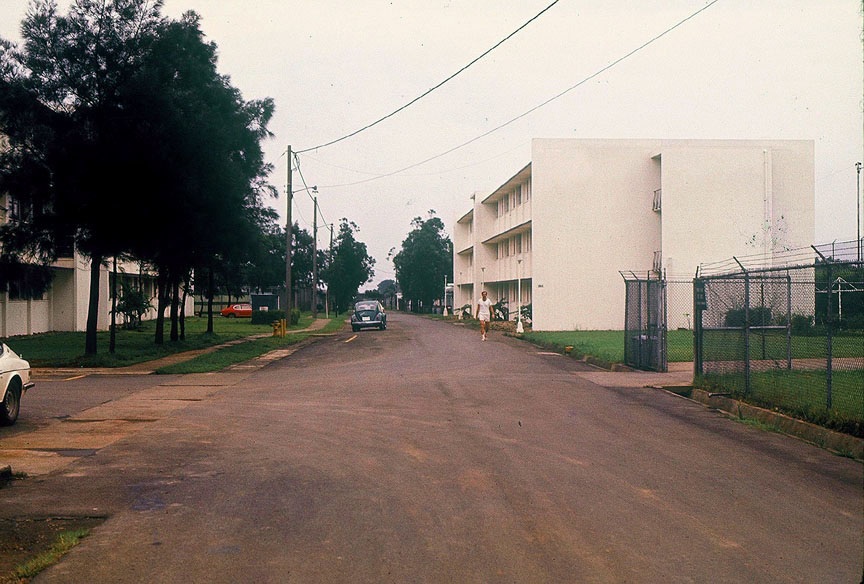
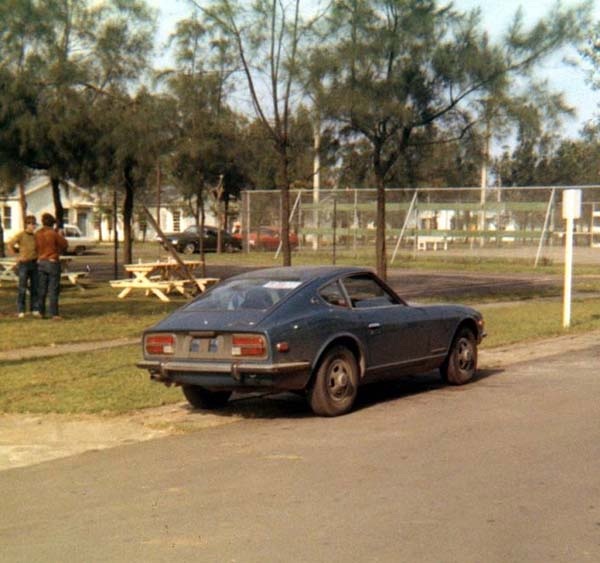
 (1.) 1976 view of the rear stairwell and entrance to Dawg Flight's second floor barracks on the left. The Base Exchange and brick trash collector (far right) are behind the barracks. Shot was taken from the Able Flight barracks, which are just off to the left.
(1.) 1976 view of the rear stairwell and entrance to Dawg Flight's second floor barracks on the left. The Base Exchange and brick trash collector (far right) are behind the barracks. Shot was taken from the Able Flight barracks, which are just off to the left.
(2.) 1976 view from Dawg Flight's second floor barracks rear entrance looking to the left. Shown is the Base Exhange (BX) on the right, the WAF dormitory stairwell, and the Telephone Exchange building in the upper background.The view to the right included the tennis courts, and the Able Flight and Navy dormitories (see next photo).
(3.) 1971 shot taken from the rear of Dawg Flight's dormitory looking toward the rear of Able Flight's dormitory (shown on far right) and the Navy dormitory (background). The Tennis Courts are just off to the left behind the trees. The sidewalk shown on the far right running between the barracks is also shown in the next photo. (Right Photo-Click to Enlarge) May 1969 shot of the Navy Barracks at Linkou.
(4.) View between the Dawg Flight (left-2nd floor) and Able Flight (right-2nd floor) barracks looking toward the rear of the barracks and the base Tennis Courts (right background-adjacent to cars) and Water Tower. The BX is behind the Dawg Flight barracks off to the left (1973 photo).
(5.) 1973 shot of the Navy dormitory, Able Flight's dormitory (far left), and the Tennis Courts behind the red car (left). Security Police Headquarters (see photos below) is on the right in the distance behind the trees just beyond the Navy barracks. The base Power Plant is behind the fence (far right).
(6.) 1971 shot of taken from the front of the Navy barracks. Shown across the street are the lighted Tennis Courts (right) behind the chain-link fence, Jim Valkwitch's new 1971 Datzun 240Z, picnic area and tables (left), and buildings (background) that were utilized for Uniform Sales, Base Laundry and Linens, Special Services, Recreation Center with pool tables and ping-pong tables, and other base facilities. The buildings were converted old open-bay barracks.

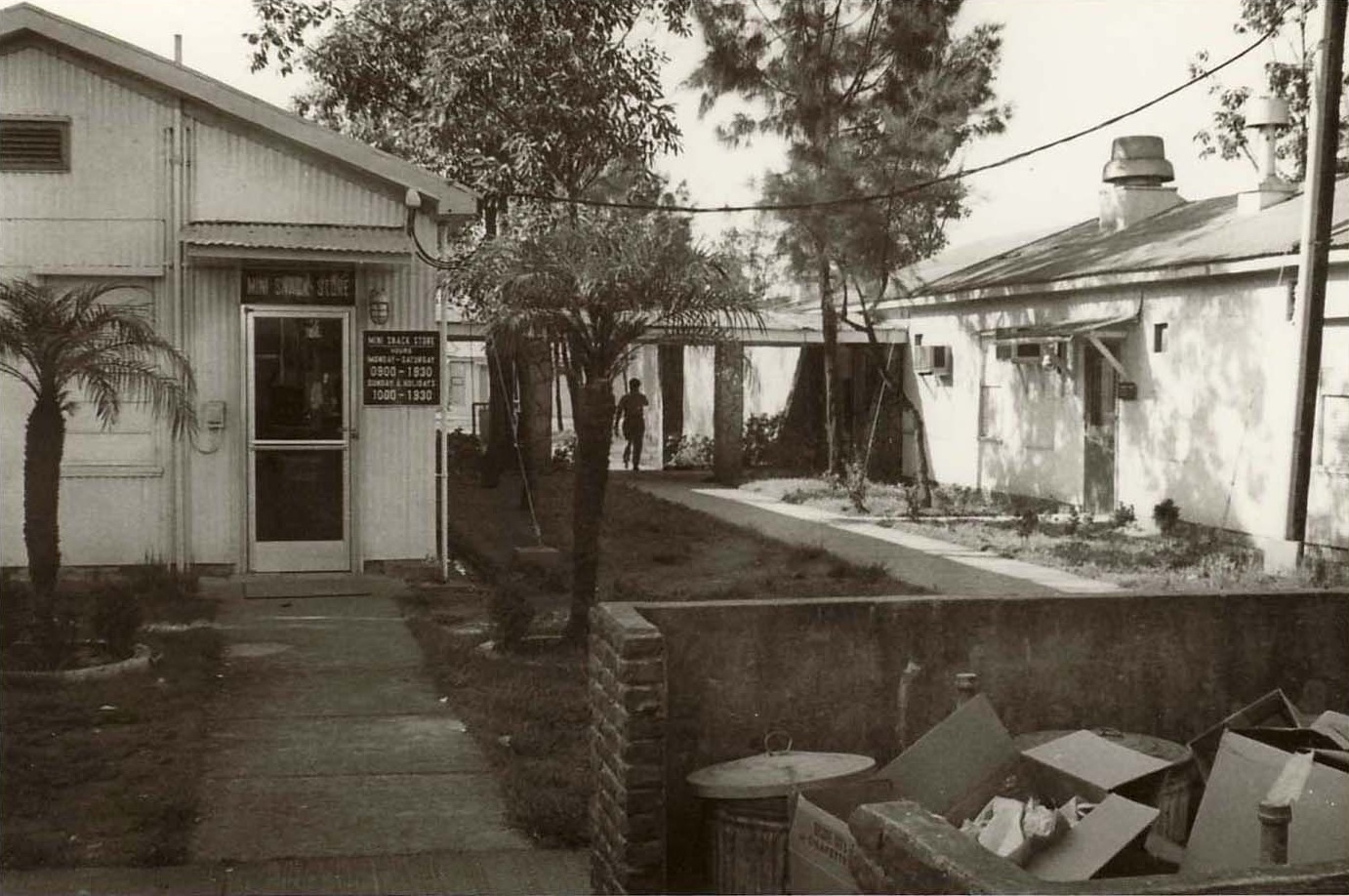
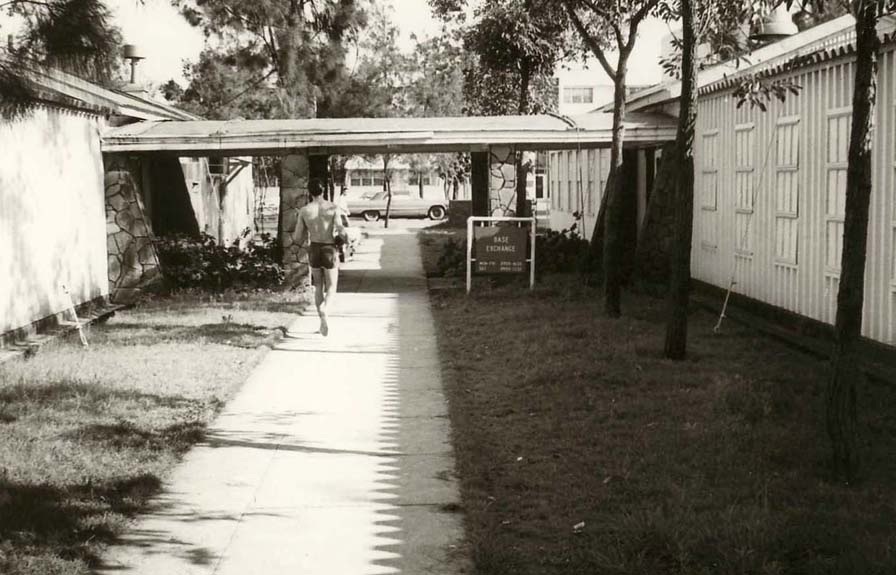
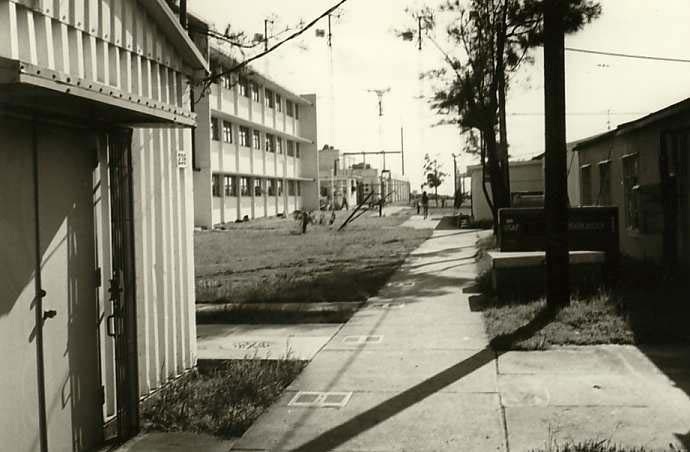
(1.) 1970 shot of the front of the two buildings that housed the BX (right bldg) and base Cleaners, Tailors, and Barber Shop (left bldg-no. 238 on "Base Map"below right and top of page). The Army/Navy barracks are visible in the background. Air Force dormitories are visible behind the BX in the upper far right background.
(2.) Fall 1971 rear shot of the BX's Mini Snack Store's entrance located at the rear of the Base Exchange (sign reads: Open 0900 to 1930 daily"). Dawg Fight's barracks are just off to the left. The brick trash collector is on the right. The building on the right (bldg 238) housed the base Barber Shop, Tailors, and Cleaners.
The new Mini Snack Store shown in the photo opened for business in the summer of 1971. It was dedicated by Colonel O. D. Graham, base commander (28 Jun 1971 to 19 Jun 1973), who succeeded Col. Barnes.
(3.) 1971 front shot of the Base Exchange's (BX) main entrance (right). The building on the left (bldg 238) housed the Barber Shop, Cleaners, and Tailors. The Barber Shop had all female barbers giving $.25 haircuts. A shave, shampoo, neck massage, manicure, and shoe shine were all about 25 cents each. The Army & Navy dormitory is in background.
(4.) 1971 base shot of the BX (far left foreground), WAF barracks (left), Ops Center (background), Telephone Exchange (1st bldg-far right), and Accounting & Finance (2nd bldg on far right).
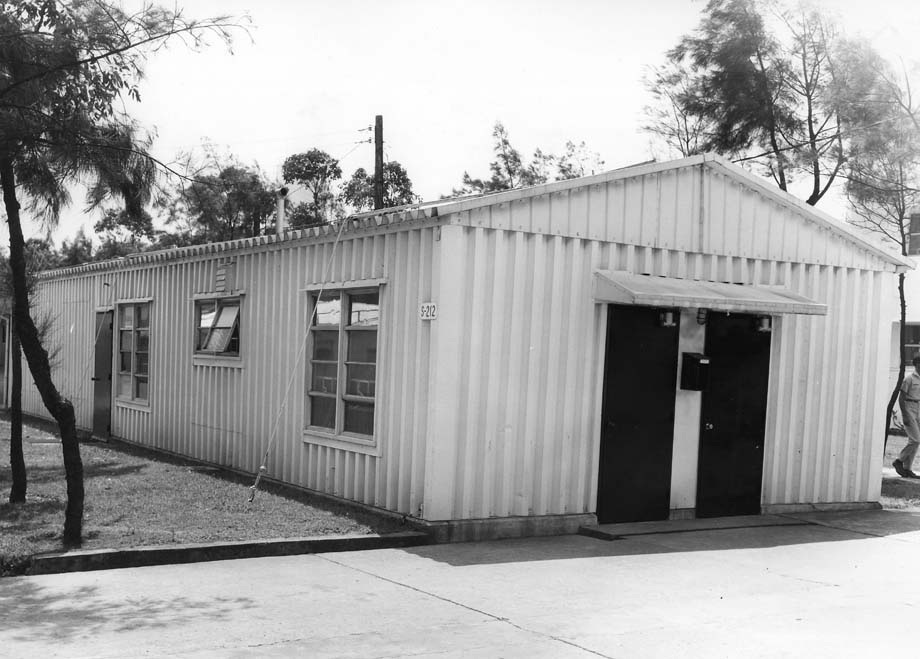
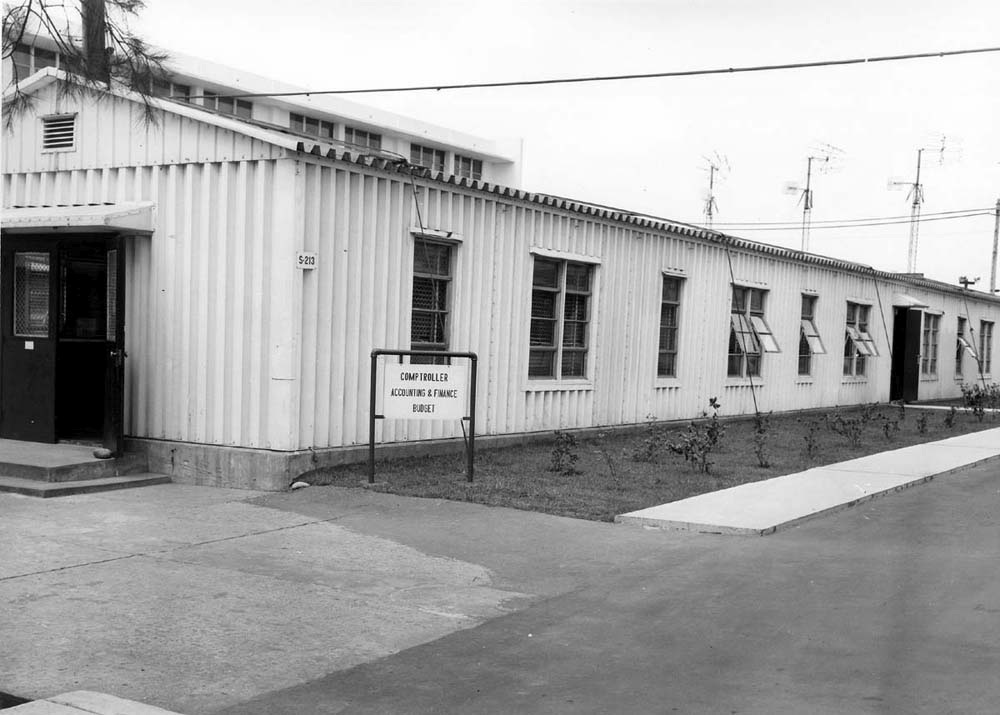
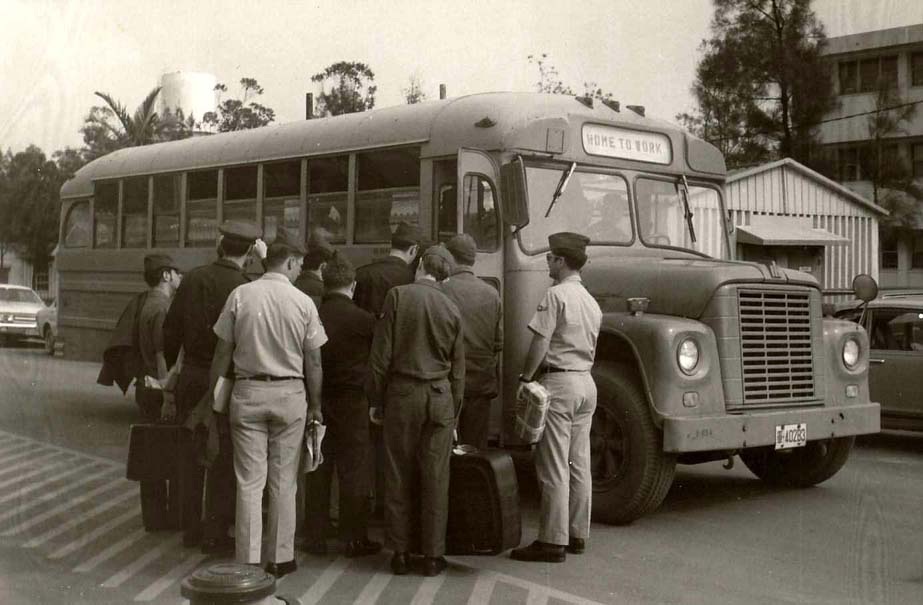
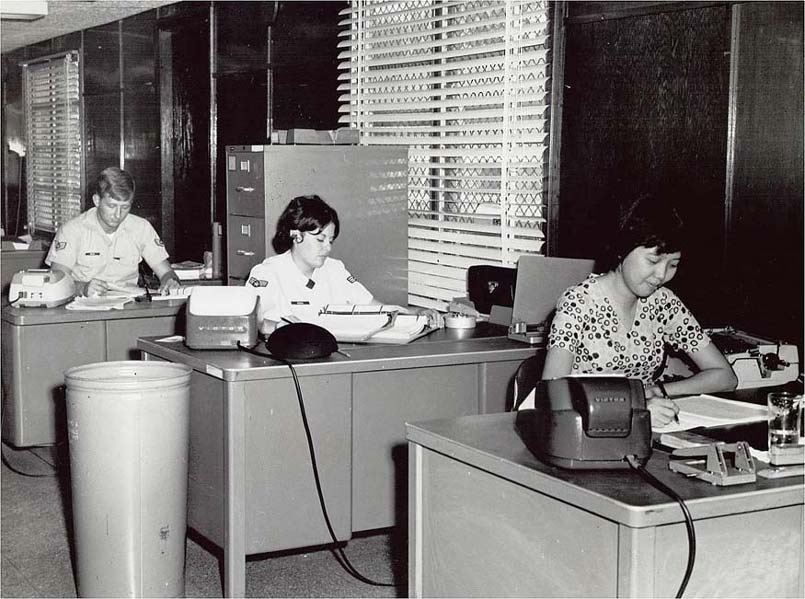
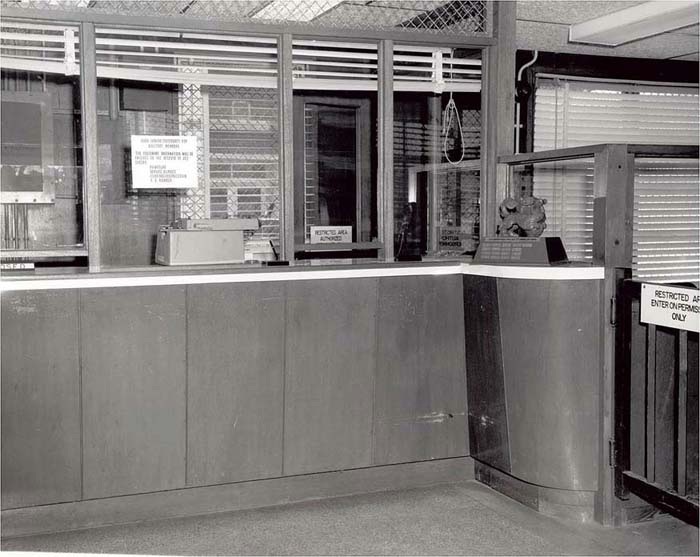
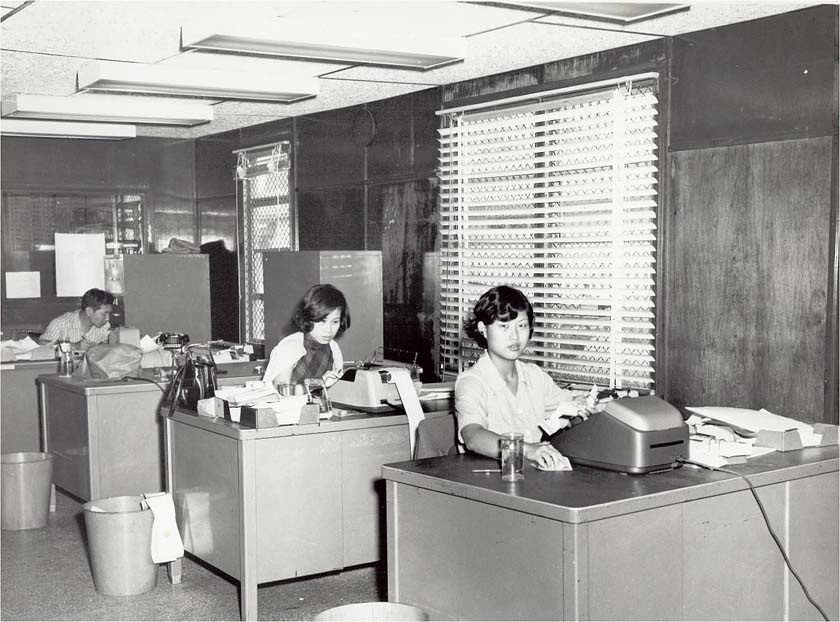
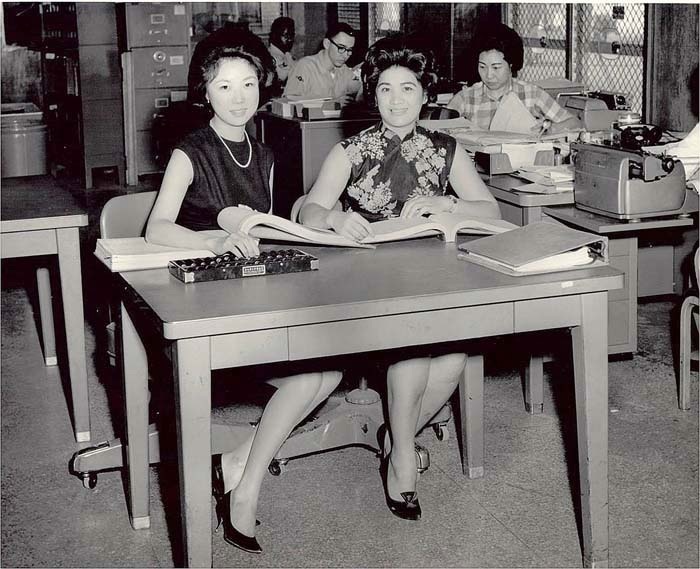
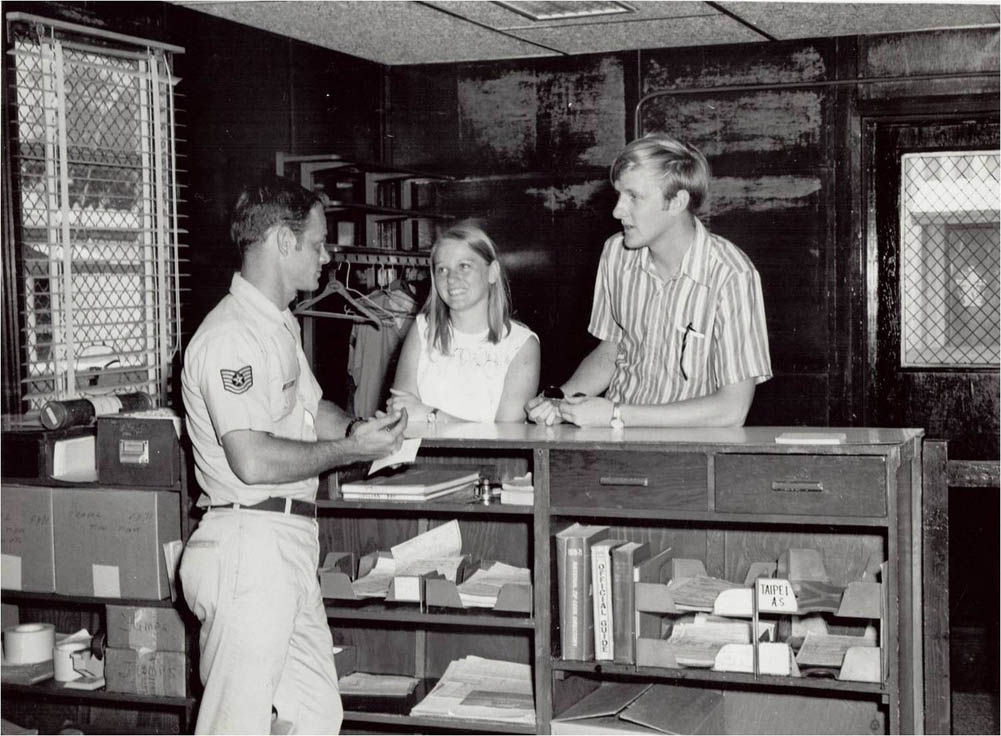
(Top Row):
(1.) May 1969 shot of the Linkou Telephone Exchange (Bldg 212-see "Base Map" below right) taken from the Accounting & Finance building (next photo), which was located in the foreground just off the photo. The Chow Hall is on the far right (background) and the BX is off to the left down the sidewalk.
(2.) May 1969 shot of the Linkou Comptroller, Accounting & Finance, and Budget building (Bldg 213), taken from the front of Telephone Exchange building (previous photo), which was located just off to the far left of the photo. Also shown are the third floor of the WAF dorm (upper left) and the Ops Center antennas (right background).
(3.) The "Smok-ah" to Taipei. A 1972 shot of "Day Ladies" boarding the Linkou Bus parked across the street from the compound, which is just off to the right of the photo. Shown in the background is the Accounting & Finance building behind the bus, and the WAF dormitory. The Telephone Exchange building was located behind the bus, to the left of the Accounting & Finance building.
(4.) May 1969 shot of a civilian employee, WAF Sgt., and SSgt. (all unidentified) in the Linkou Commercial Services Section of Accounting & Finance.
(Bottom Row):
(1.) Linkou's Account & Finance service counter (May 1969 photo).
(2.) Linkou's Accounting & Finance. Civilian employees (front to back) : Ms. L. Shih (see narrative and photos below), Lina (last name unknown), and unidentified (May 1969 photo).
(3.) 1969 photo of Linkou's Accounting & Finance. Unidentified civilian employees and airmen.
(4.) TSgt. Vento, Linkou Accounting & Finance, discussing a housing allowance with A1C Mofatt and his wife (May 1969 photo).
Mr. Chi-Wen Shih ("The General"), Shulinkou: 1957-1977
Michael Shih: "I did find a picture with my sister, Ms. L. Shih, in it on the website (photo 2.- bottom row above). She was 19 at that time. She worked at the base for some time (first in Accounting & Finance and later in Civil Engineering).
My dad, Mr. Chi-Wen Shih (photos below), worked at Shu Linkou Air Station 20 years, from 1956/57 (when the base opened) to the date that the Americans departed Taiwan (April 1, 1977). He was known as the "General." He worked first in base maintenance as a plumber and later at the Shu Linkou movie theater. He passed away in 2006, at the age of 83. He learned to speak English from the British in Burma where he served with the ROC Army, was self-taught to be a plumber, married a beautiful Chinese woman, and was able to raise five children to adults with the good jobs you Americans gave him at Shulinkou. Thank you very much.
I made one visit to the base, on Independence Day in 1968, when I was 12. I had so much fun, and was impressed with the high standards of living of Americans, which was one of the reasons I left Taiwan in 1981. I moved to Minnesota and eventually became a Canadian citizen." [03 Apr 2015]
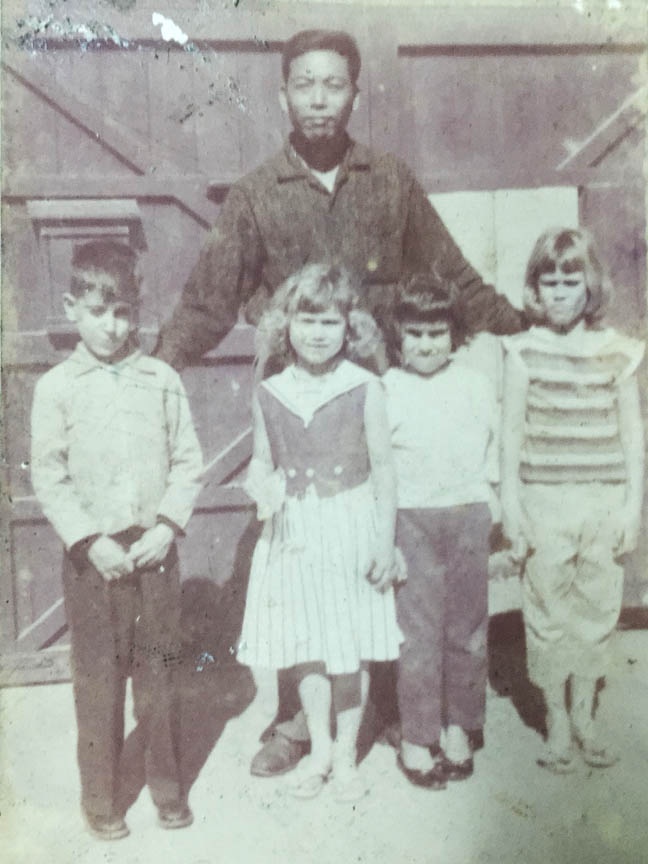
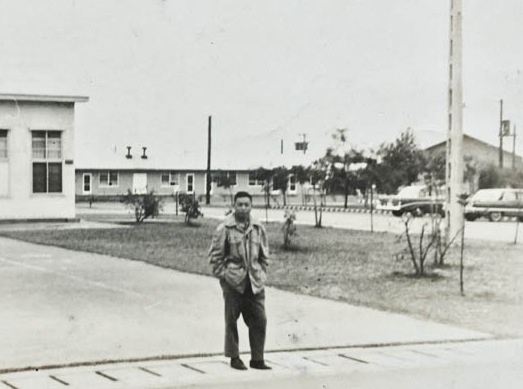
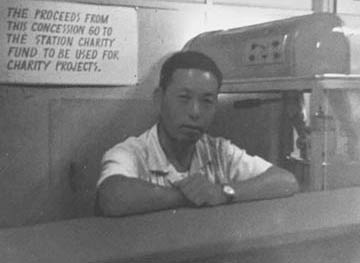
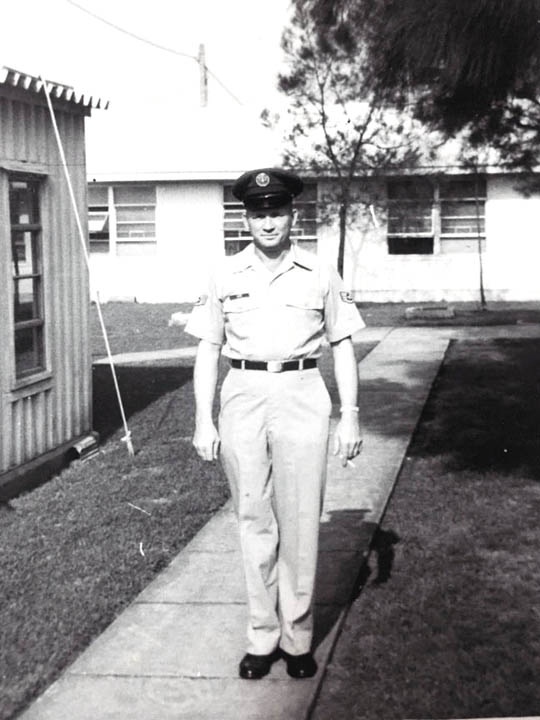
(1.) Mr. Chi-Wen Shih (Shulinkou: 1957-77), acclaimed civilian employee at Shulinkou for 20 years, shown on base with military dependent children. (2.) Circa 1965 shot of Mr. Chi-Wen Shih, known on base as "the General", in front of the Linkou Club (far left). (3.) Circa 1970 shot of Mr. Shih at the Shulinkou movie theater concession stand. (4.) Unidentified SSgt. at Shulinkou, who was Mr. Shih's coworker and friend.
Michael Shih: " It was a pure coincidence that when I served in the ROC army in 1978-1980 as a second lieutenant, I was assigned to 168th Division, Logistic Support Battalion, located in Linkou at that time. And I worked for a few months in the base right next to the Shu Linkou base, which at that time was used for training ROC military police (link to webpage below). At that time, my dad was still working at Shu Linkou, as a contract worker for Taiwan's Defense Department. The local brass would consult him on everything related to the equipment and facilities located on Shu Linkou, as he had served on the base under American control for so many years. He knew all the ROC generals and colonels on base and had their ear. One time, I saw a full colonel ask him "very politely" to explain how the heating and air conditioning systems worked at Shu Linkou (A/C for barracks was unheard of in the ROC army). All the American equipment simply baffled them. That is how important he was there." [03 Apr 2015]
Click Here to go to Shu LinKou Air Station: 1977 thru 1996 - ROC Military Police Training
Les Duffin (1962-63, 1964-66): "The dining hall at Shulinkou was always a highlight. One year when they didnít win the Hennessy Trophy, they were so embarrassed they remodeled the whole place (new fountain & fish pond among other things) and added a row of Hibachi cookers out back so, when you went through the line you were asked if you wanted your meat cooked or smoked." [July 2008]
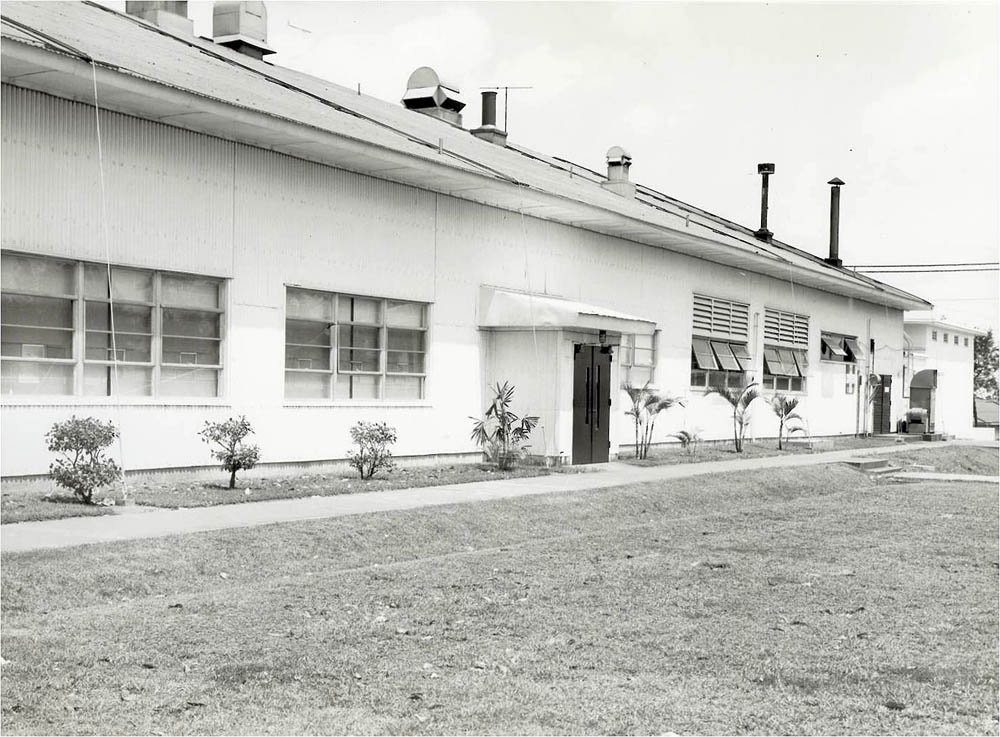
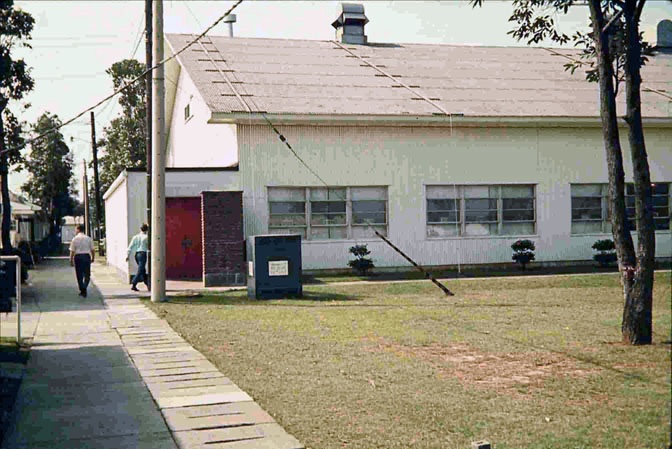
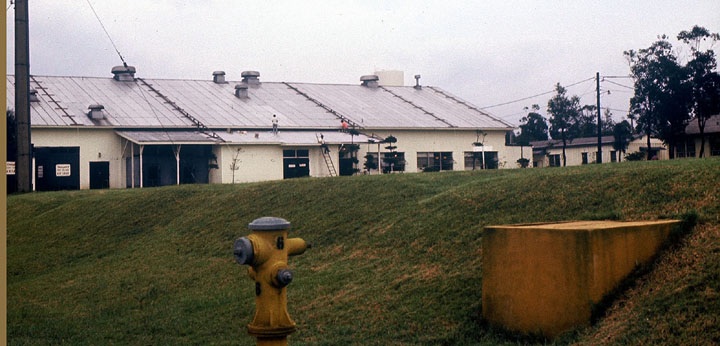

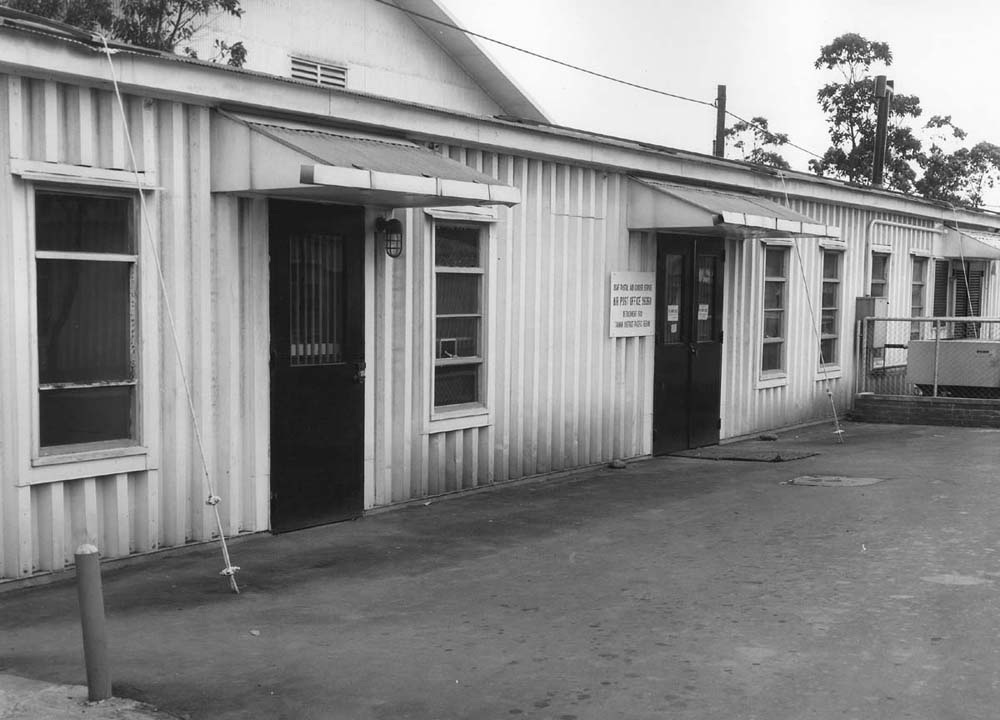
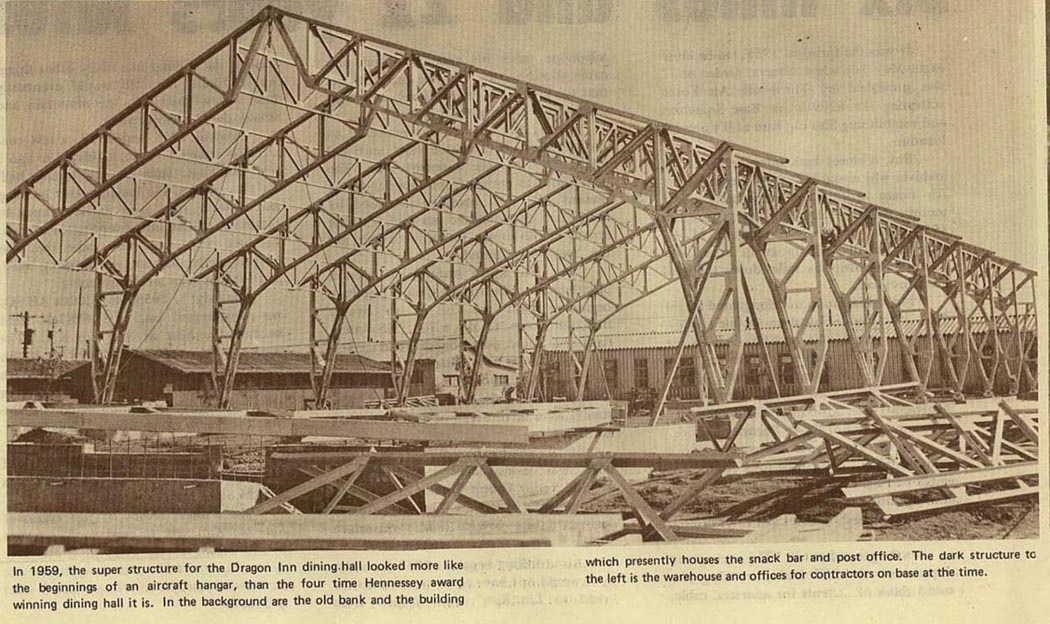 (1.) May 1969 shot of the front of the Dragon Inn Dining Hall, built in 1959 (1959 Photo on Left-Click to Enlarge). Consistently rated the best dining hall in the Air Force, the Dragon Inn won the Hennessy Trophy (see photos below) four times: 1968, 1969, 1973, and 1974. The side entrance (see next photo), which was the most utilized during this time frame, is just off to the left of the photo.
(1.) May 1969 shot of the front of the Dragon Inn Dining Hall, built in 1959 (1959 Photo on Left-Click to Enlarge). Consistently rated the best dining hall in the Air Force, the Dragon Inn won the Hennessy Trophy (see photos below) four times: 1968, 1969, 1973, and 1974. The side entrance (see next photo), which was the most utilized during this time frame, is just off to the left of the photo.
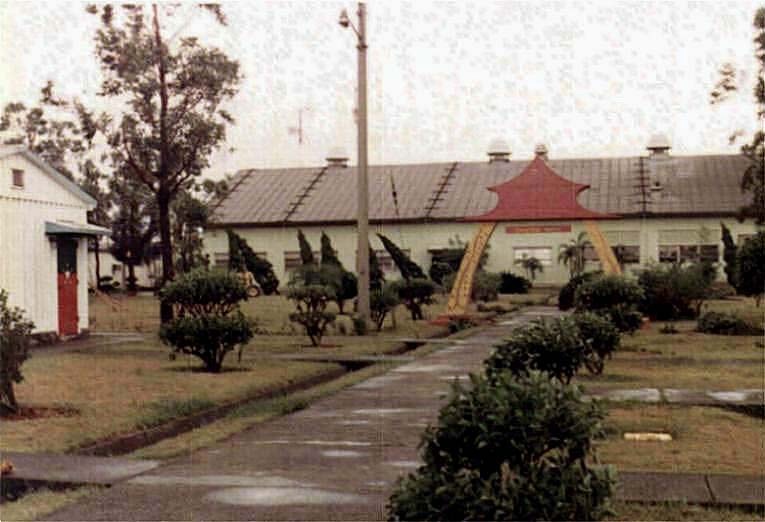
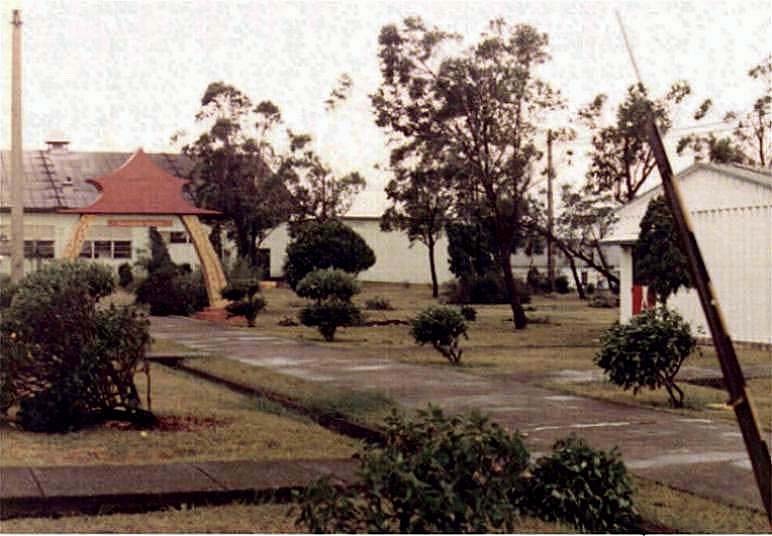
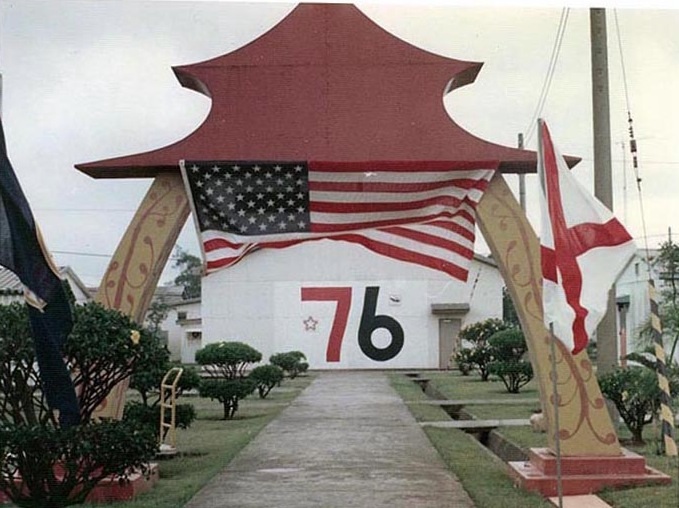
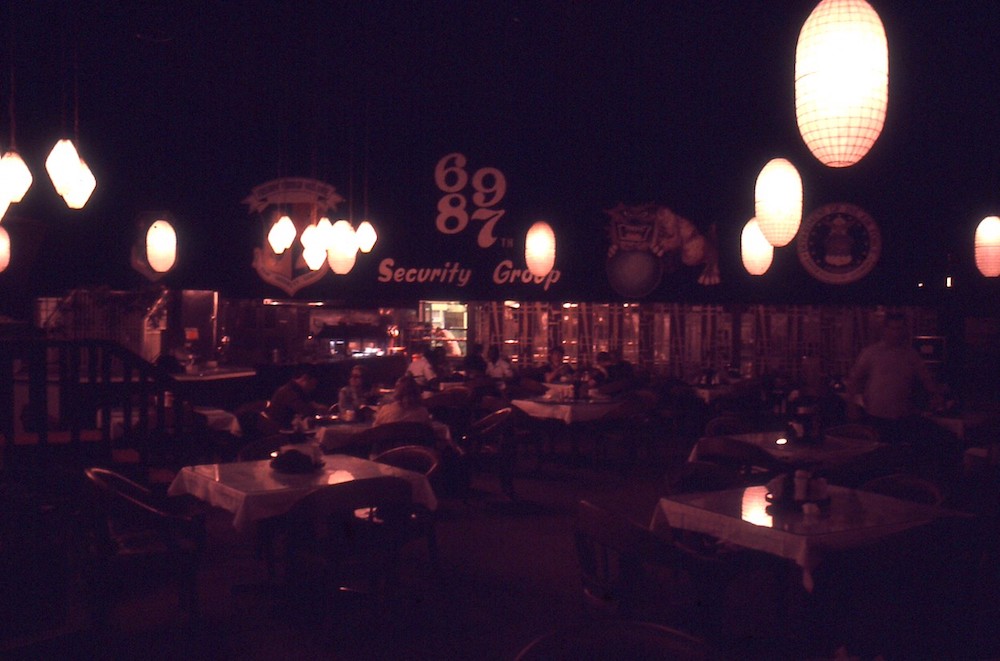
(1. & 2.) Two sequential shots of the Dragon Inn Dining Hall taken in August 1976 from the rear of the Linkou Club showing "Typhoon Billie's" (August 12, 1976) damage. During this time frame, the Dragon Inn was painted light green from its original white color, an ornate archway over the sidewalk was added, and its trees and shrubs are taller (compare to earlier 1970s photos above). (Photo 1.) Shown are the base Personnel Office (CBPO) on the far left, Mail Room (left background), and Dragon Inn. (Photo 2.) Dragon Inn (left), Base Education Office (far right) and Motor Pool (right background).
(3.) July 4, 1976 shot of the entrance to the Dragon Inn Dining Hall on Independence Day during the U.S. Bicentennial celebration.
(4.) 1976 shot of "Midnight Chow" at the Dragon Inn. Midnight Chow was served from about 2300-0100 hours daily, and was primarily for airmen and officers working swing and mid shifts. However, it was open to everyone on base, including anyone returning from a hard night on the town. In addition to Midnight Chow, the Dragon Inn served breakfast, lunch, and dinner daily.
"In April 1974 base services received word that the Dragon Inn had made Air Force history by winning the coveted John L. Hennessey Trophy for the fourth time (1974, 1973, 1969, and 1968. Also, it was runner-up in 1965.) Other awards the Dragon Inn had garnered included the Commander's Trophy for the best food service facility in the Pacific Security Region for five straight years beginning in 1960 (1960-65), and the outstanding USAFSS Food Service Award for 1965, 1966, 1968, 1969, 1972, 1973, and 1974." ( source: Shulinkou Devil Dog base newspaper, Feb. 23, 1977 edit.) provided by Katie Jarvis (1976-77) & Roger Jarvis (1975-77)
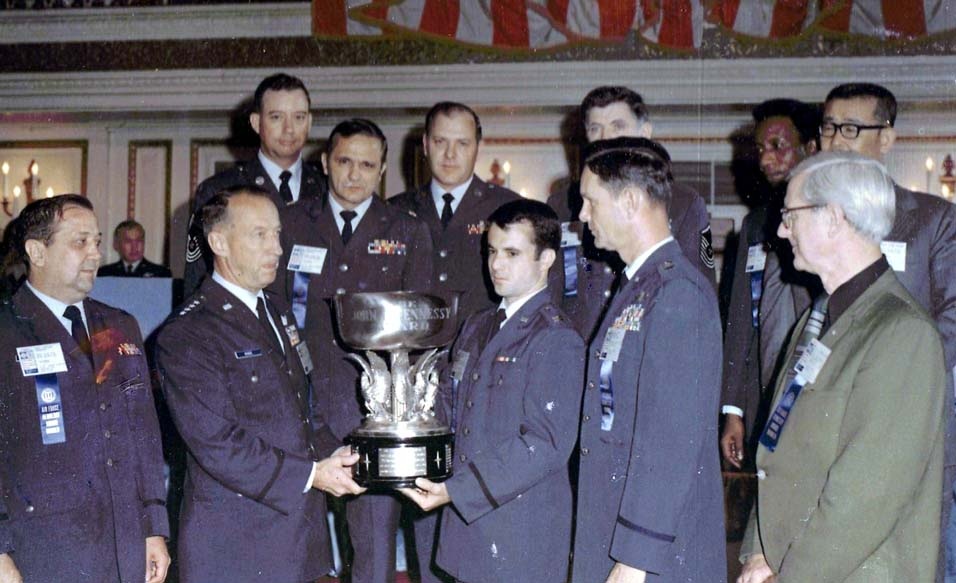
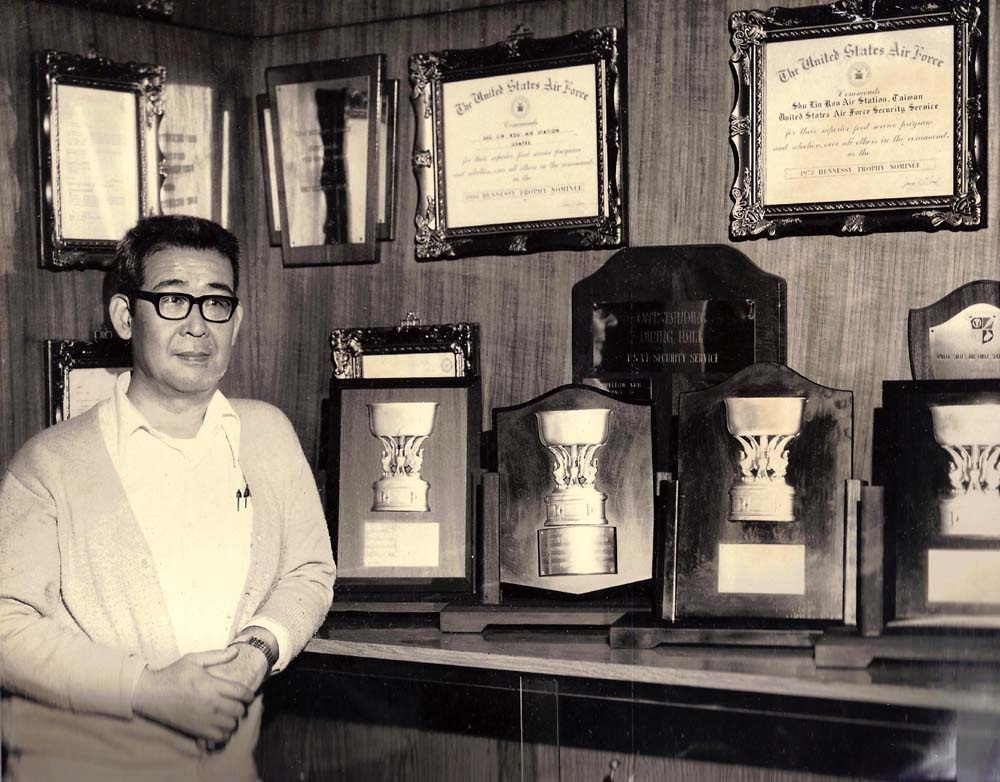
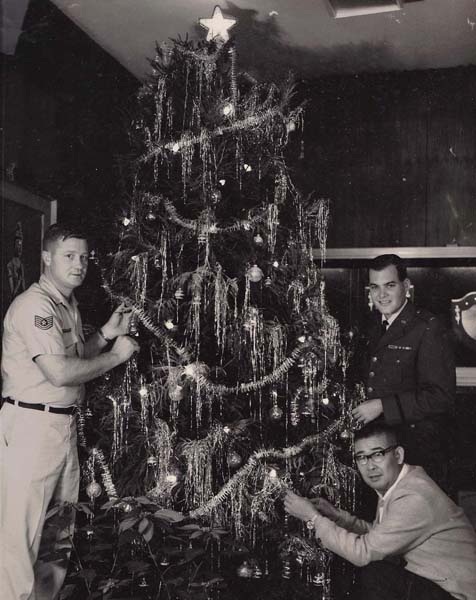

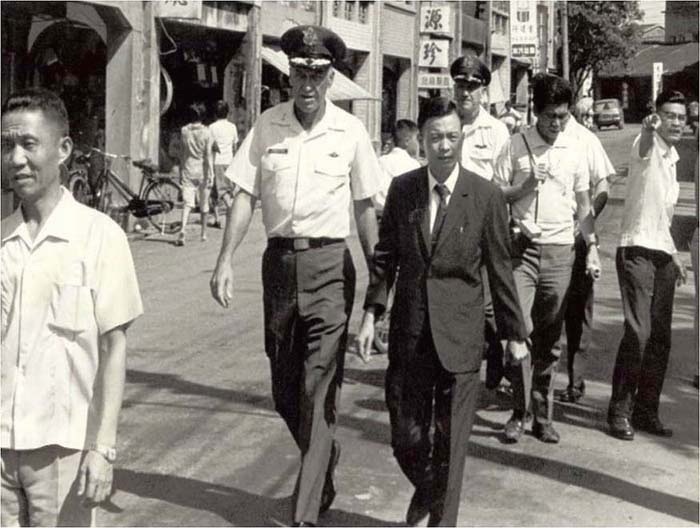 (1.) May 1973 shot taken at the Officer's Club in Taipei of Captain Wayne Garber (center), Shulinkou Special Services commander (Officer in Charge of the Dragon Inn), receiving the coveted
USAF John L. Hennessy Trophy (Click Here for Website) for the best dining hall in the Air Force in 1973. This was Shulinkou's third Hennessy Trophy, having won it previously in 1969, and 1968. (In May 1965 the Dragon Inn was named runner-up for the Hennessey Trophy.) It won the award again the next year in 1974 for a record fourth time.
(1.) May 1973 shot taken at the Officer's Club in Taipei of Captain Wayne Garber (center), Shulinkou Special Services commander (Officer in Charge of the Dragon Inn), receiving the coveted
USAF John L. Hennessy Trophy (Click Here for Website) for the best dining hall in the Air Force in 1973. This was Shulinkou's third Hennessy Trophy, having won it previously in 1969, and 1968. (In May 1965 the Dragon Inn was named runner-up for the Hennessey Trophy.) It won the award again the next year in 1974 for a record fourth time.
Identified in the photo are (first row, L-R): Colonel Oscar D. ("O.D.") Graham (far left), Shulinkou Base Commander (28 June 1971 to 19 June 1973); General (Four-Star) John W. Vogt, Jr. (presenting trophy), Commander in Chief of the Pacific Air Forces (1973-74); Captain Wayne Garber (receiving trophy), Shulinkou Special Services commander; and Major General Walter G. Galligan (to the right of Captain Garber), Commander of the USAFSS (1973-74). Mr. Hwa Jing Wong, Dragon Inn manager, is shown in the upper far right of photo.
(Photo on Right-Click to Enlarge) Circa 1972 shot of Major General Clark W. Stapleton, Commander of USAFSS from July 19, 1969 to Feb 23, 1973, and Colonel James S. Novy (background), USAFSS (PSR CC), touring Taipei during a visit to Shulinkou Air Station, which included inspecting the Dragon Inn. Major General Walter T. Galligan (pictured above) replaced Major General Stapleton as Commander of USAFSS, Feb 24, 1973 to May 20, 1974. photo credit: with permission and courtesy of USAF ISR Agency History Office
(2.) Circa 1975 photo of Mr. Hwa Jing Wong, who was the manager of the Dragon Inn dining hall for almost 20 years until the base closed on April 1, 1977. Mr Wong was instrumental in the Dragon Inn achieving its outstanding success and legendary reputation. The shot shows the Hennessy Trophies and many other awards the dining hall received over the years.
Shown in the foreground are four Hennessy Award plaques depicting the Dragon Inn's Hennessy Trophies for 1968, 1969, 1973, and 1974. The trophy rotated annually to the new winner and a replica plaque depicting the installation's achievement was exchanged for the actual trophy. Several other Dragon Inn awards are shown on the wall including 1966 (center) and 1972 (right) "Hennessy Trophy Nominee" certificates, and the 1965 Hennessy Trophy Runner-Up plaque.
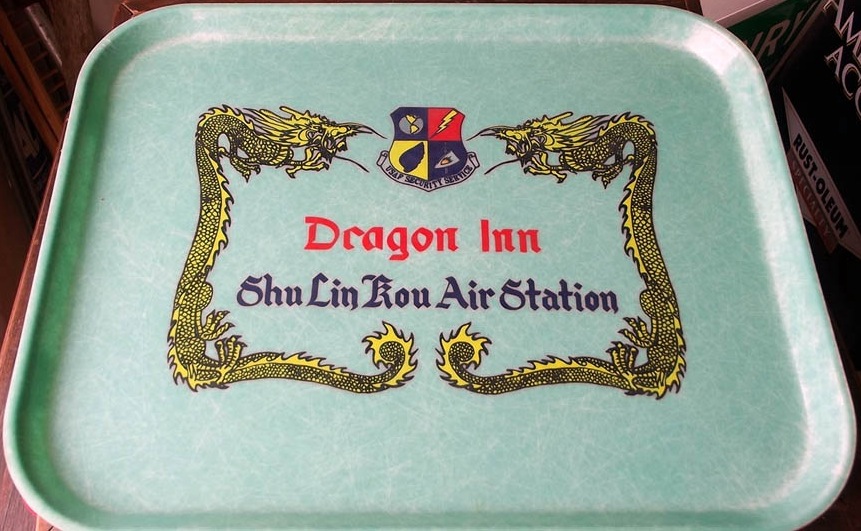 (Photo on Right-Click to Enlarge) Decorative serving tray used to help win the 1973 and 1974 Hennessy Trophies. photo credit: unknown (provided by Jim Valkwitch-Linkou navy '71-'72)
(Photo on Right-Click to Enlarge) Decorative serving tray used to help win the 1973 and 1974 Hennessy Trophies. photo credit: unknown (provided by Jim Valkwitch-Linkou navy '71-'72)
(3.-above) Circa 1970 shot of the Dragon Inn Christmas tree. From the left: Unidentified TSgt, who was the NCO in Charge (NCOIC) of the Dragon Inn; Mr. Hwa Jing Wong; and an unidentified Lieutenant, who was the Special Services commander (Officer in Charge of the Dragon Inn). Full course turkey dinners with all the trimmings were served on Thanksgiving and Christmas holidays.
(4.) Circa 1973 view of the Dragon Inn after entering through the side entrance vestibule. In the foreground is the large white circular reception, sign-in desk, goldfish pond, fish fountain, and raised waterway. The waterway (added ca. 1965) separated the dining room...officers to the left and airmen to the right. The serving line is along the back wall. The wheeled metal carts behind the palms (left) are self-serve ice cream freezers for sundaes. Beer vending machines were off to the right. The Dragon Inn served breakfast, lunch, dinner, and "midnight chow" (see photo above) daily.
(5.) Circa 1974 shot of the Dragon Inn dining hall, goldfish pond, and fish fountain. The bridge over the waterway, new chairs, and squadron signs were added after 1971. The ice cream freezers are on the left behind the large potted plant.
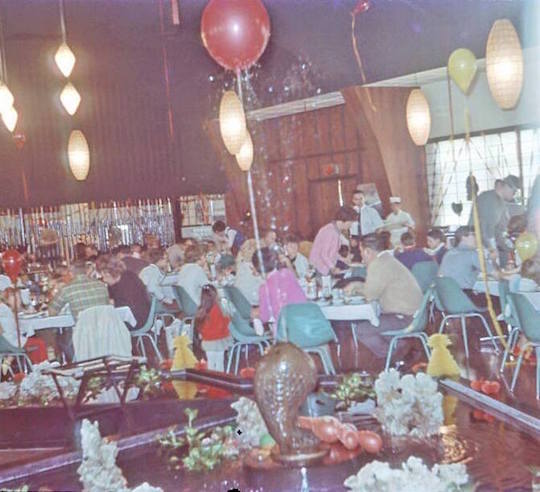
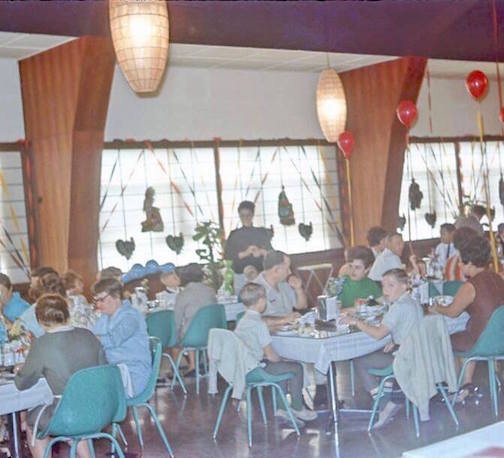

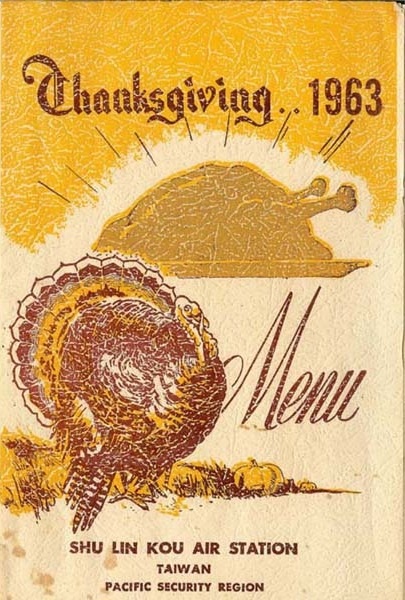
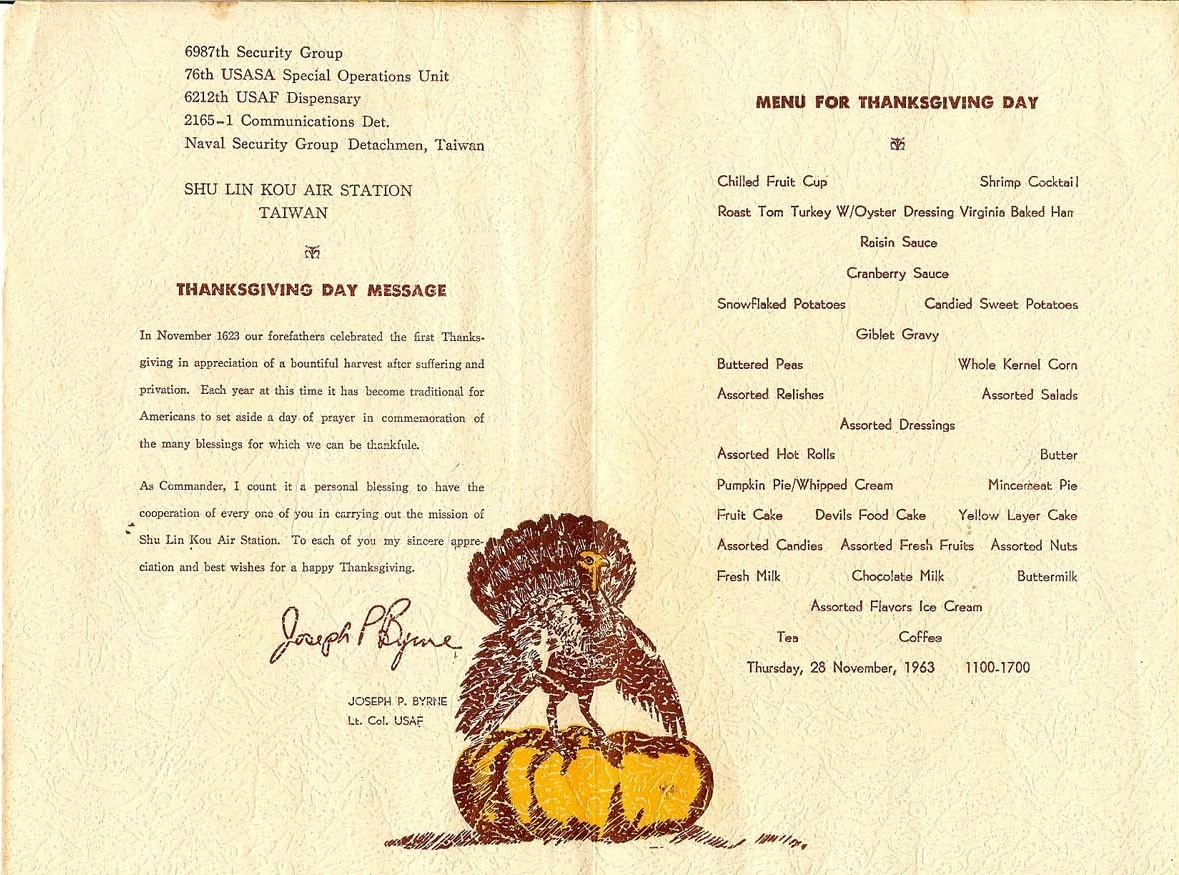
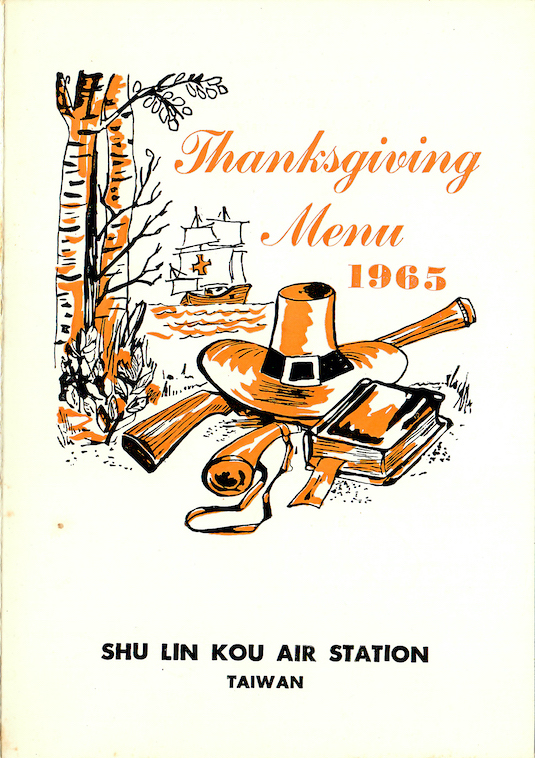
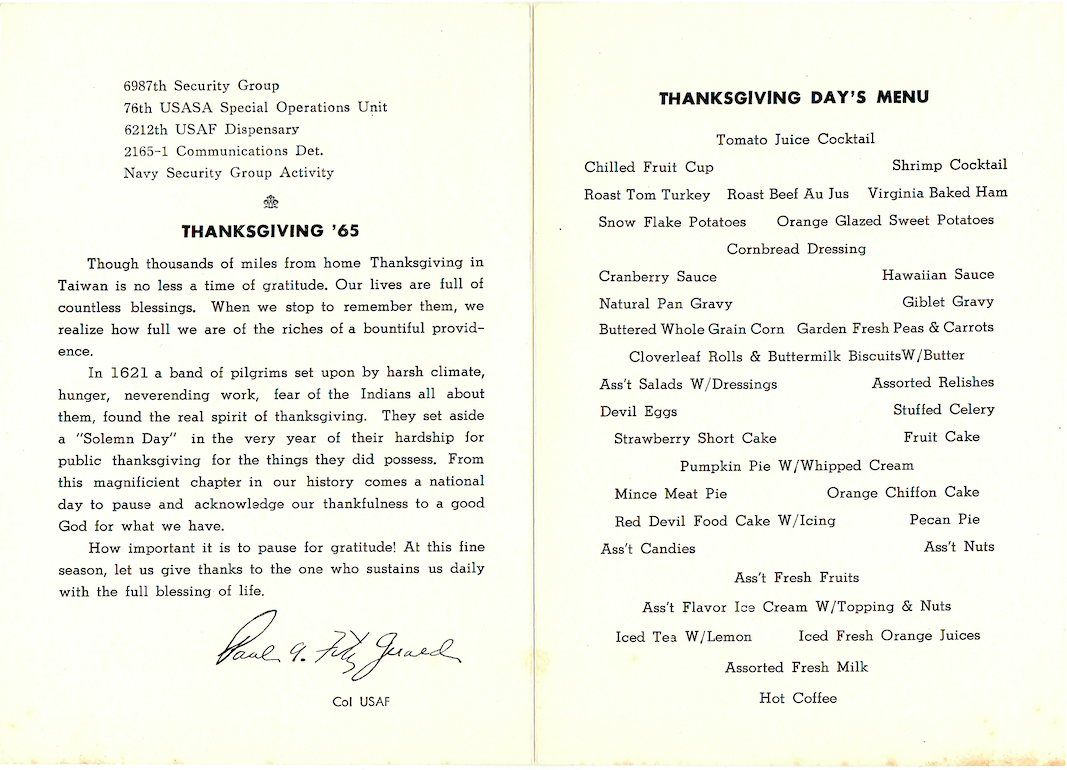
(top row) (1. & 2.) 1969/70 photos of Thanksgiving dinner at the Shulinkou Dragon Inn dining hall. Military personnel and their families were welcome including their "amahs" (maids). In the first photo (photo no. 1.) the Dragon Inn's goldfish pond and fish fountain are shown in the foreground.
(3.) 1965 Thanksgiving festivities.
(bottom row) (1., 2., 3. & 4.) 1963 and 1965 Thanksgiving Day menus with Thanksgiving Day messages from Base Commanders Lt. Colonel Joseph P. Byrne (1962-1964) and Colonel Paul A. Fitzgerald (1964-1965).
John Hurst (Taipei Air Station: 1972-73): "I do remember the spectacular Thanksgiving dinners at the Taipei Air Station and Shu Linkou Dining Halls. We went to Shu Linkou in 1973, and it was fabulous. I think the cost was $1.55 each for me and spouse; children under five were free! I went with my boss and his family, and can still remember that great meal and all the trimmings for less than $5.00." [24 Nov 2010] (courtesy of "TaipeiAirStation.blogspot.com")
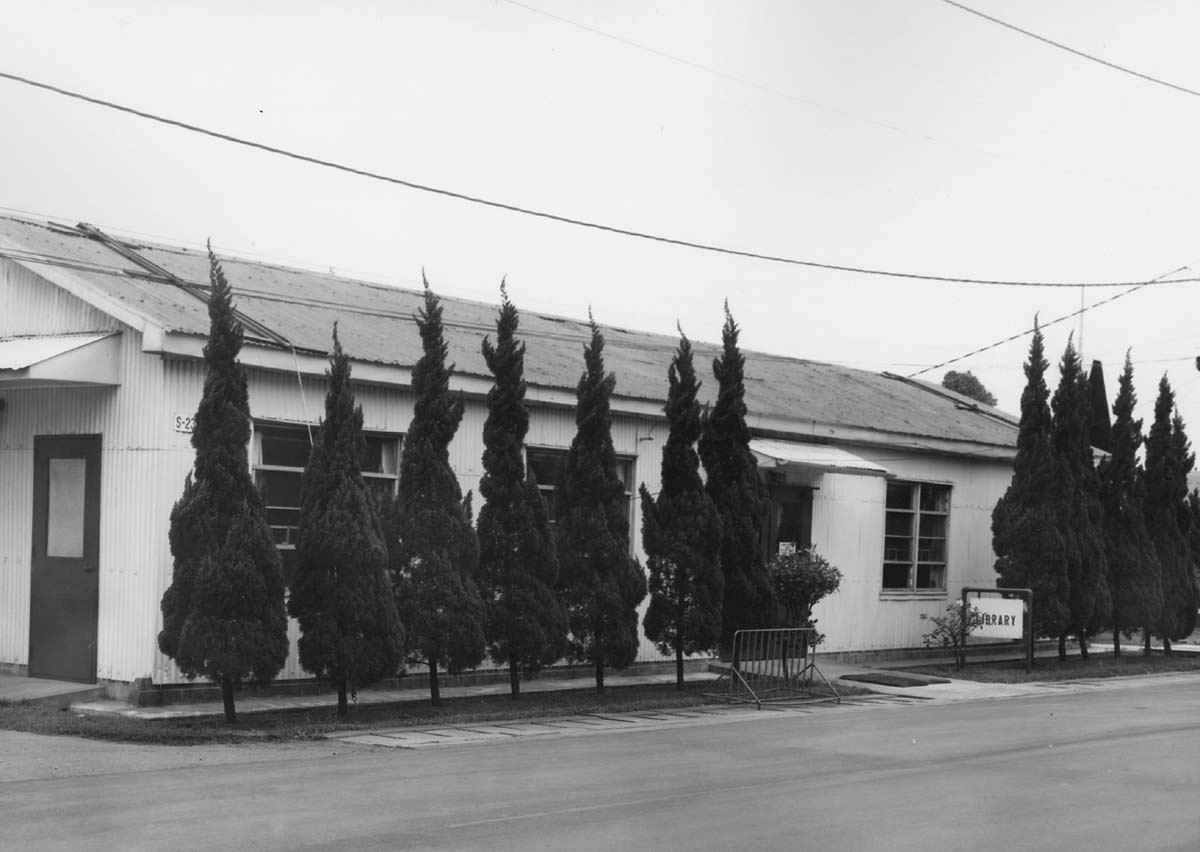
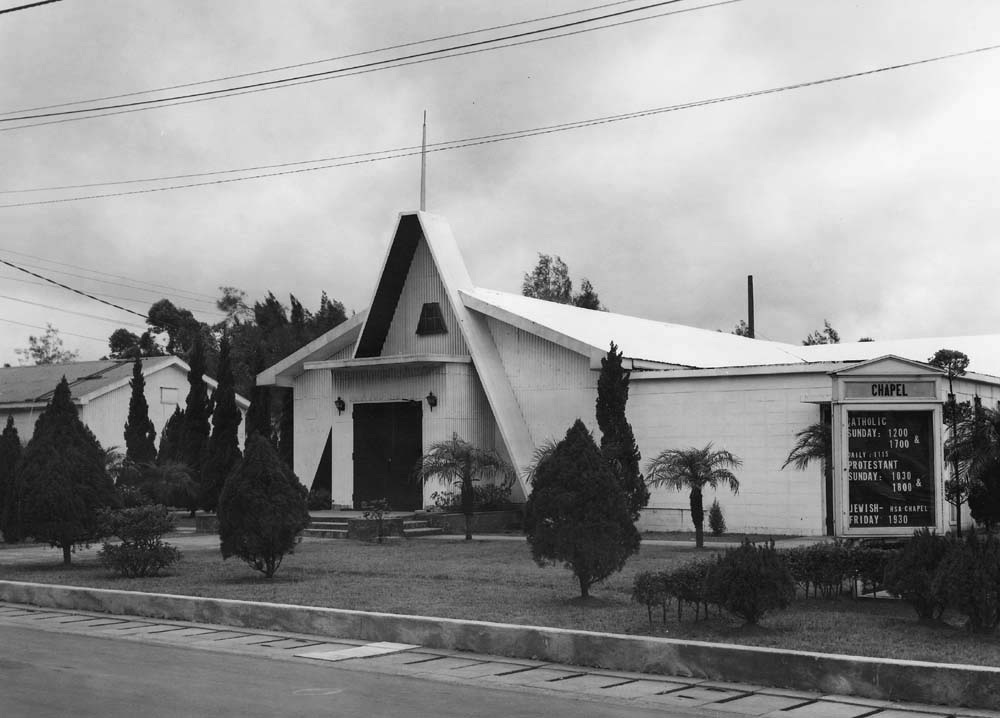
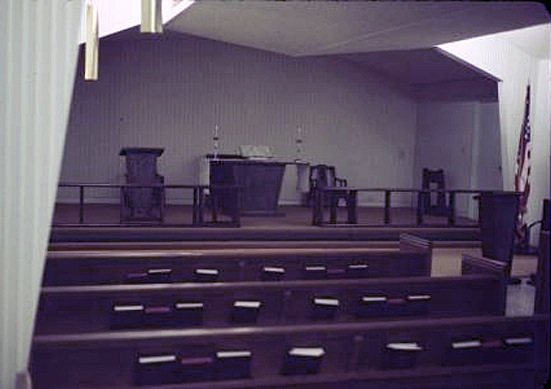
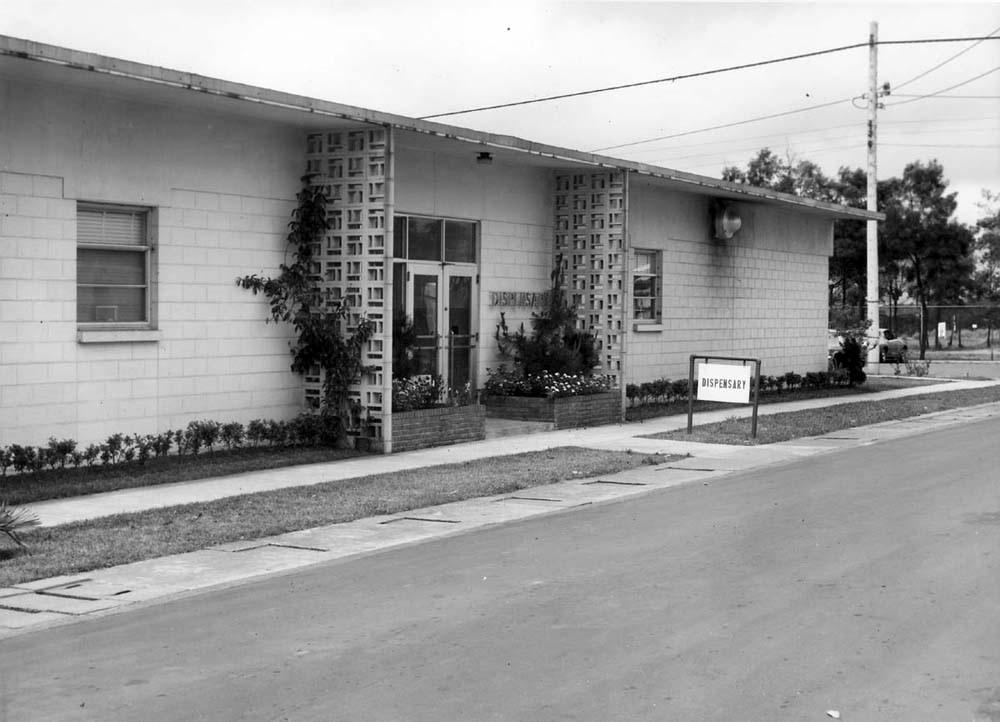
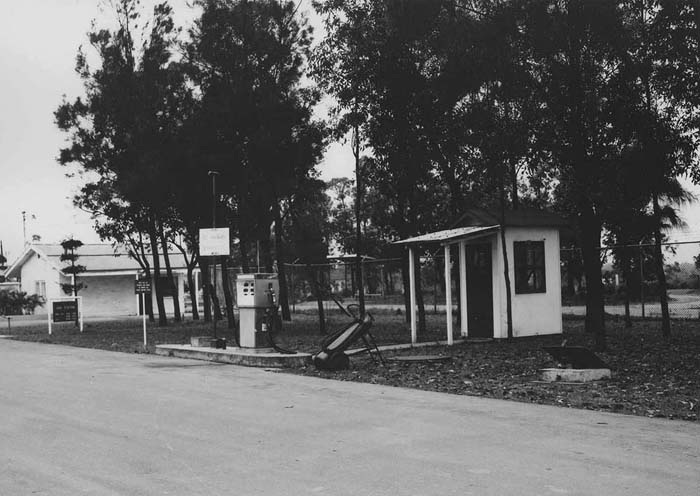
(1.) May 1969 shot of the Linkou Library. The Chapel was located next door, just off to the right of the photo.
(2.) May 1969 shot of the base Chapel located between the Library (visible on far left) and Dispensary, which is just off to the right of photo. The base Swimming Pool (photos above) was located right behind the Chapel.
"The Shulinkou Protestant Choir was named the best in the USAFSS in January 1966 and in March 1966 was named the best in the Air Force. In 1967 the Catholic choir at Shulinkou was named the best in Security Service. The Catholic choir was selected based on a tape recording evaluated along with recordings from other Security Service choirs." (source: the Shulinkou Devil Dog base newspaper, Feb. 23, 1977 edit.) provided by Roger Jarvis (1975-77)
(3.) 1967/68 interior shot of the Linkou Chapel.
(4.) May 1969 shot of the 6212th Dispensary taken from the Chapel. The adjacent Linkou Club was located behind the Dispensary building in the photo.
(5.) May 1969 shot of the base Gas Station located across the street from the Chapel and near the old central main gate (Guard Shack shown in far left background).
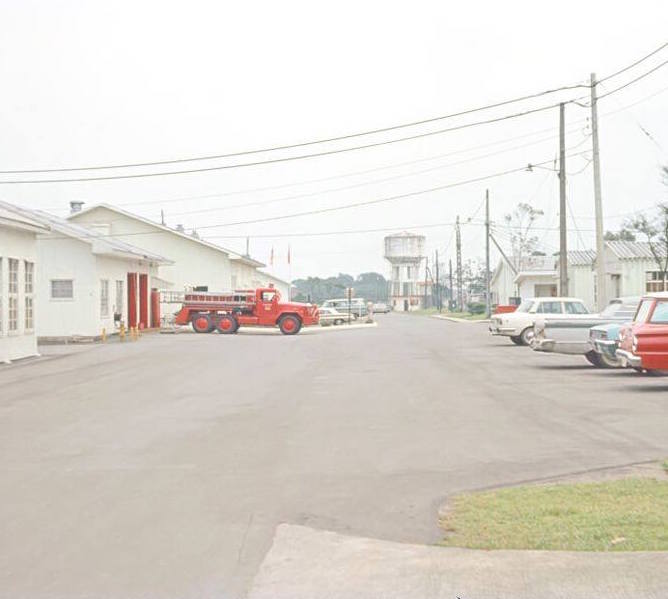
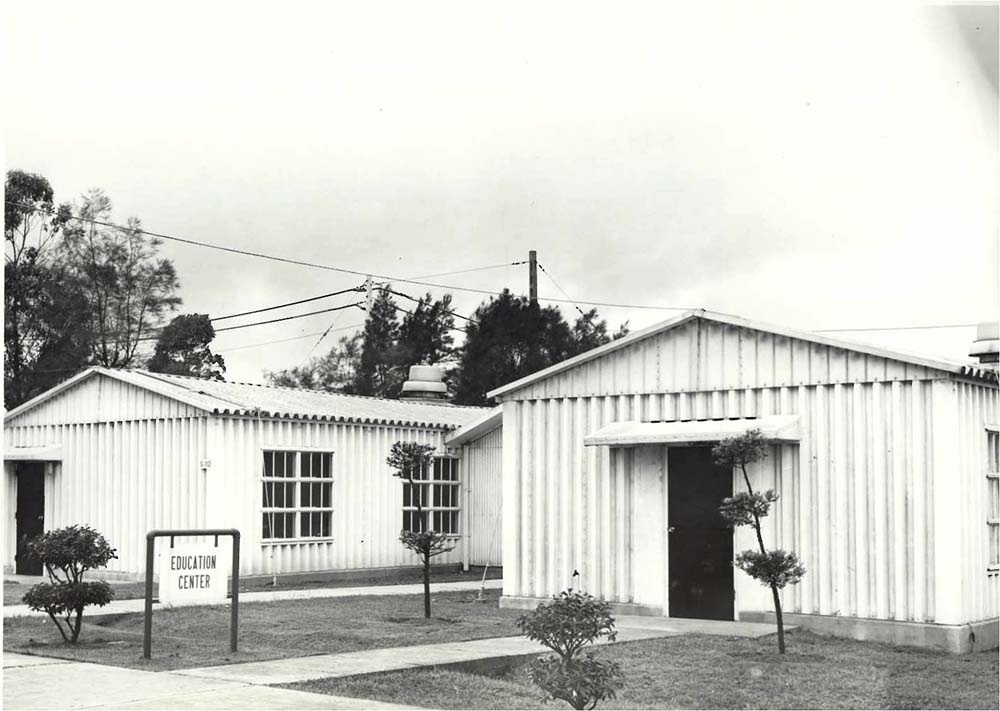
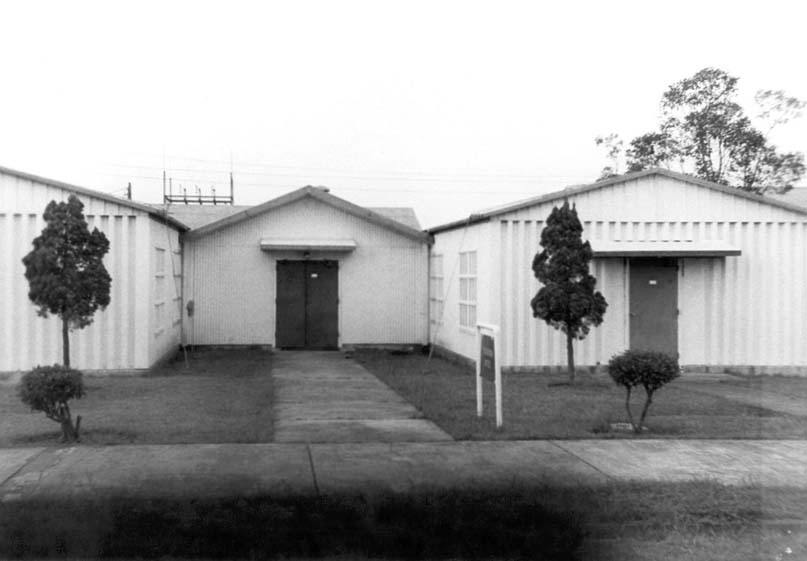
(1.) Circa 1968 shot taken from the street adjacent to the Dining Hall (off to far right) looking east toward the Main Gate (Guard Shack in distance at old water tower). Buildings visible on the right: Base Education Office (two bldgs beyond cars, Bldg 112, - Note: a converted old open bay "H-shaped" barracks), Linkou Bus Stop shelter (open front shelter just beyond the cars and red can), Linkou Club Office and Storage building, Guard Shack, and old water tower (located outside base). Buildings visible on the left: Motor Pool (bldg on far left), Fire Department, Theater, and Headquarters (at flags).
(2.) May 1969 shot of the Linkou Education Office located behind the Linkou Club and across the street from the Fire Station. The Linkou Bus Stop shelter was located to the right rear of the Education Office on the street behind it. The Dining Hall was located off to the left of the photo and the Linkou Club was located off to the right.
(3.) 1966 shot of the base Education Office.
Note: Work on the new Education Center in building S-112, began in January 1967 and was completed in June 1967. Prior to that the Education Office shared building S-223 with Special Services.
The building that housed the Education Center was previously an old H-shaped, corrugated-metal, open-bay barracks. The barracks latrine and showers were located in the center cross section shown above. After the new dormitories were completed in 1966, several of the old metal barracks throughout the base were converted to administrative office and support buildings. All the other old metal barracks on base were demolished.
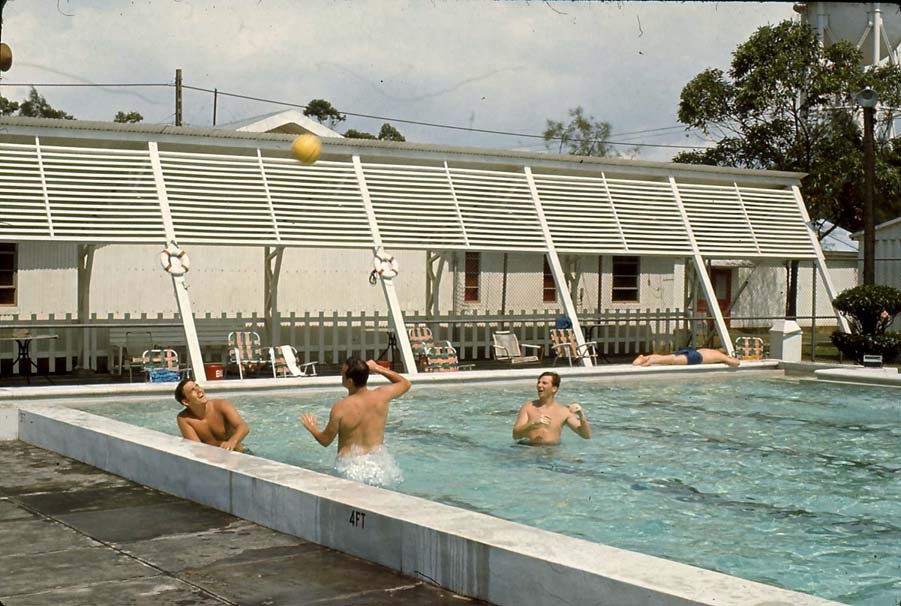
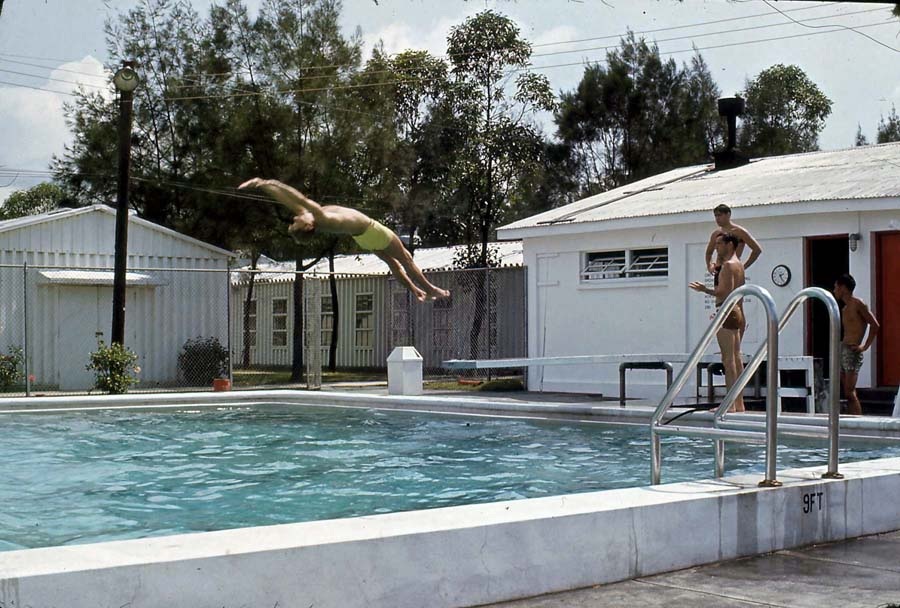

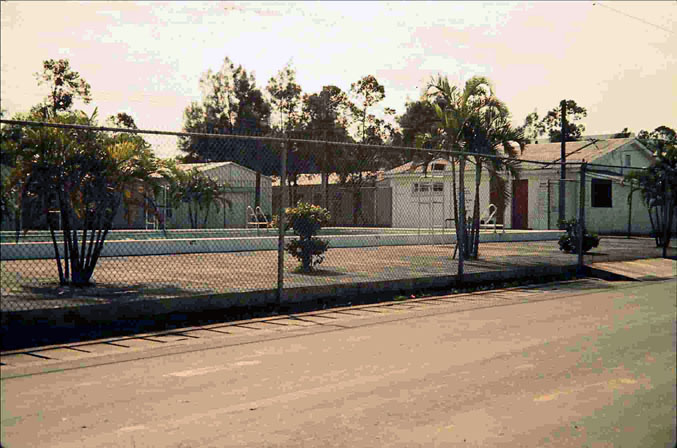
(1.) 1970 shot of Linkou's Olympic standard pool, completed mid-1958, and the rear of the Chapel (far left) behind the slatted roof of the pavilion.
(2.) The pool house/cabana and diving board in 1970. Administrative and support buildings are in the background.
Note: Several converted barracks buildings located behind the barracks and adjacent to the swimming pool were used for Uniform Sales, Base Laundry and Linens, Special Services, and the Recreation Center with pool tables and ping-pong tables.
(3.) 1970 shot of the lighted Linkou Swimming Pool and pool house/cabana.
(4.) 1970 street view of the Swimming Pool and pool house (far right) taken while walking back to the barracks from either the Linkou Club or Linkou Bus Stop. "THE PHANTOM": "We walked past the Swimming Pool everyday. If it had water in it we never noticed...or cared...!"
(Left Photo-Click to Enlarge) 1970 shot of the Swimming Pool, pool pavilion (far left), and base Water Tower. The rear of the Chapel is on the far left behind the pool pavilion. The other two buildings are converted corrugated metal barracks used as offices.
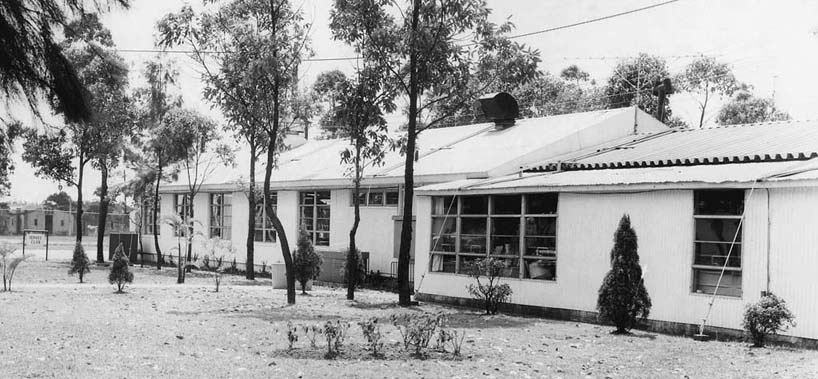
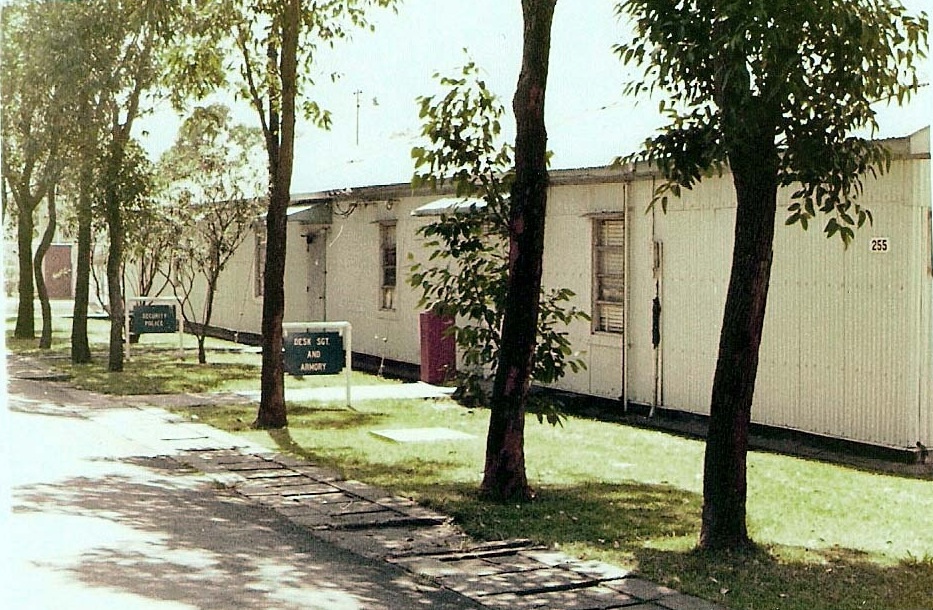
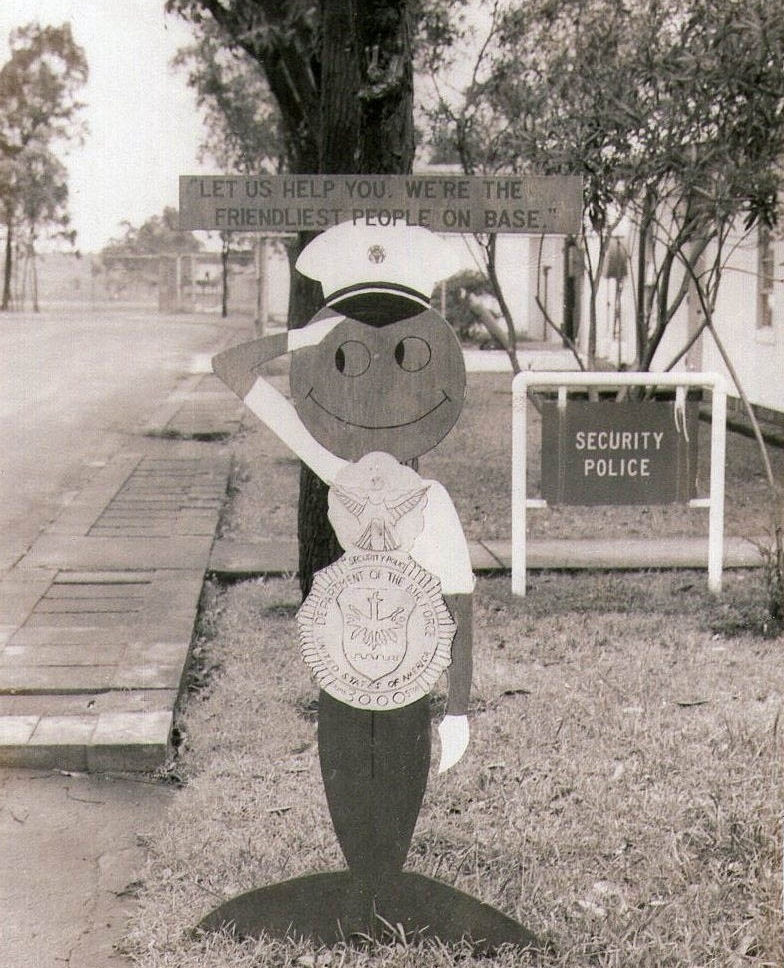
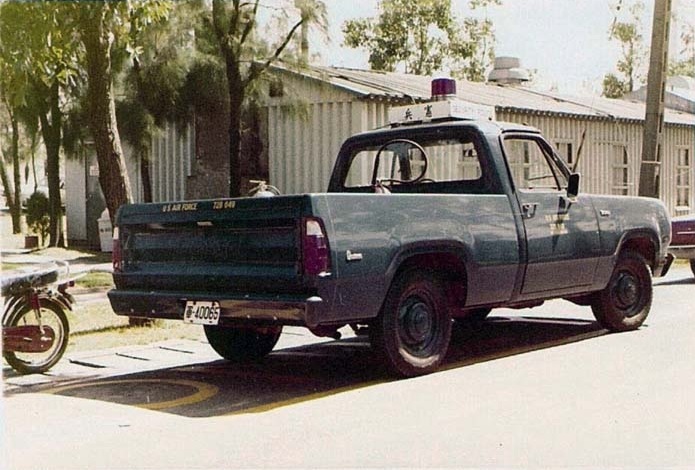
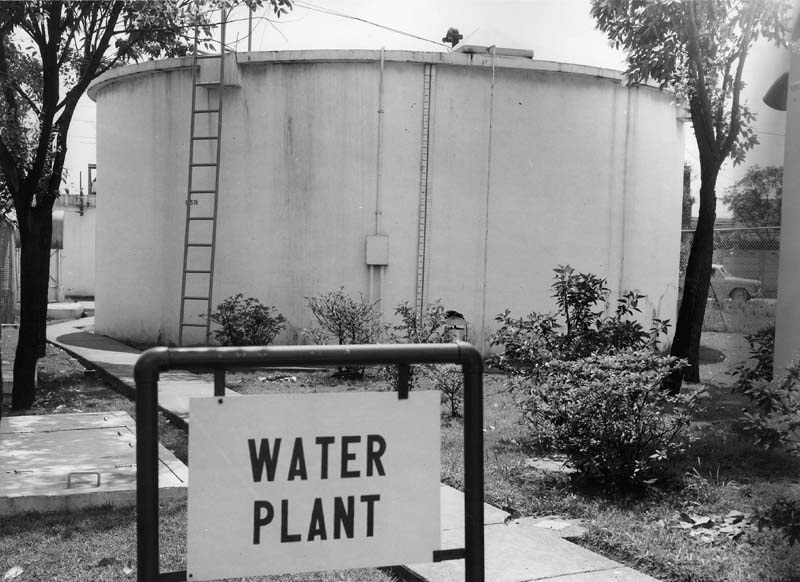


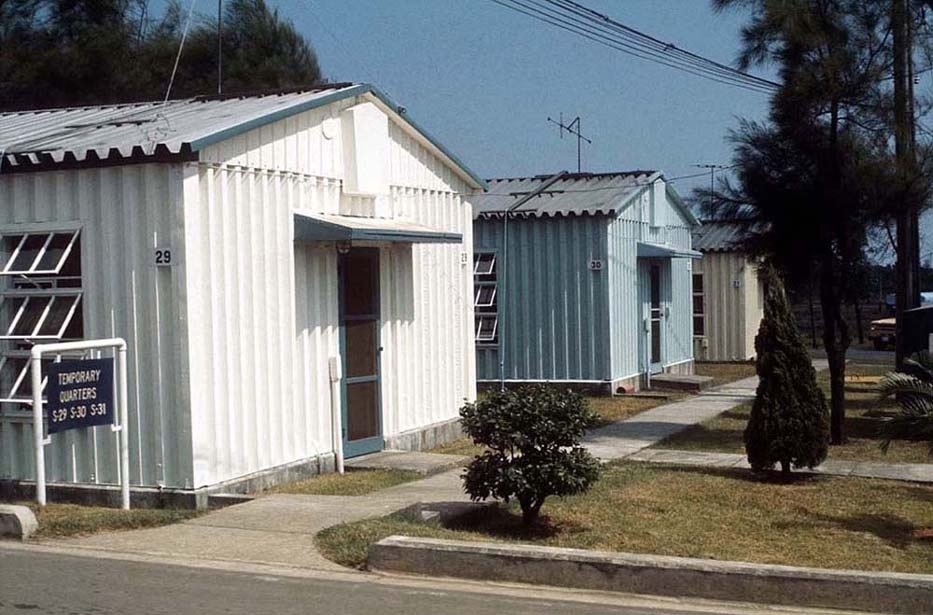
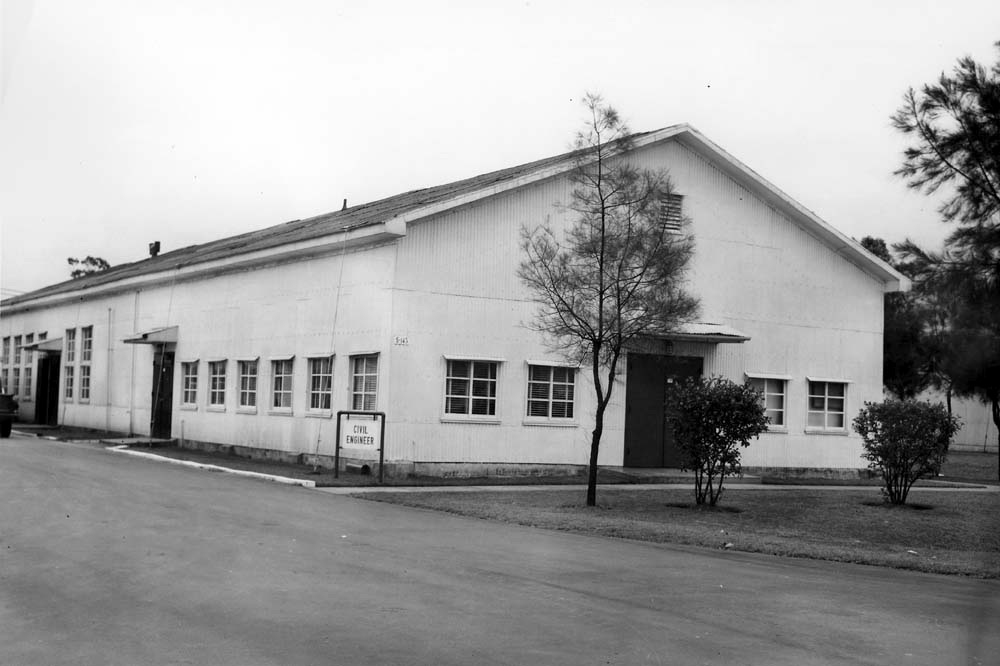
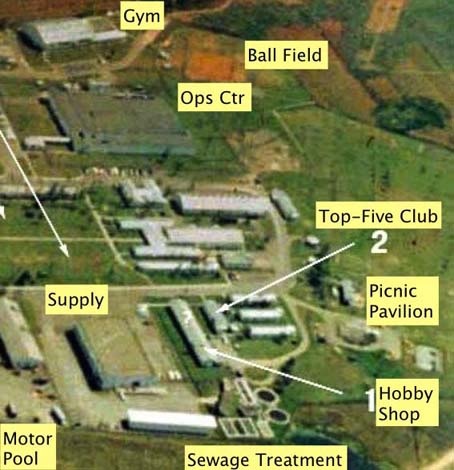
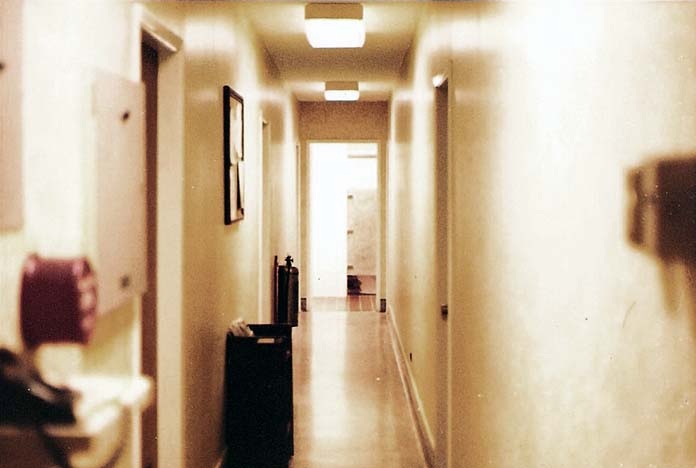 (1.) 1970 shot of the Picnic Pavilion located on the back side of the base adjacent to the 5-hole pitch-and-put golf course (open area on right side of aerial photo on left). The Dining Hall (on left in distance) and Civil Engineering building (on right-see photo 4.) are in the background.
(1.) 1970 shot of the Picnic Pavilion located on the back side of the base adjacent to the 5-hole pitch-and-put golf course (open area on right side of aerial photo on left). The Dining Hall (on left in distance) and Civil Engineering building (on right-see photo 4.) are in the background.
(2.) 1970 shot of several Dawgs at the Picnic Pavilion prior to playing a round of golf on the adjacent Linkou links located behind the Ops Center. Bottom row (from left): unidentified, Lee "Rhee" Higgins. Top row (from left): Ray "Rudy" Sorensen, Dave "Doink" Vandierdonck, Mike "Mouse" Emerson, and George "Sergio" Raseta.
(3.) 1970 shot of the three Temporary Quarters (Transient Barracks) buildings (bldgs no. 29, 30, & 31) on the back side of base. (Photo on Right-Click to Enlarge) 1973 interior shot of the Temporary Quarters.
(4.) The Civil Engineering headquarters building (bldg. 145) located on the back side of base where Civil Engineer officers and senior NCOs worked. Also inside were classrooms and a large conference room.
(Left Photo-Click to Enlarge) 1970 aerial photo of the buildings located on the back side of base. The Golf Course was located in the open area on the far right of the photo.
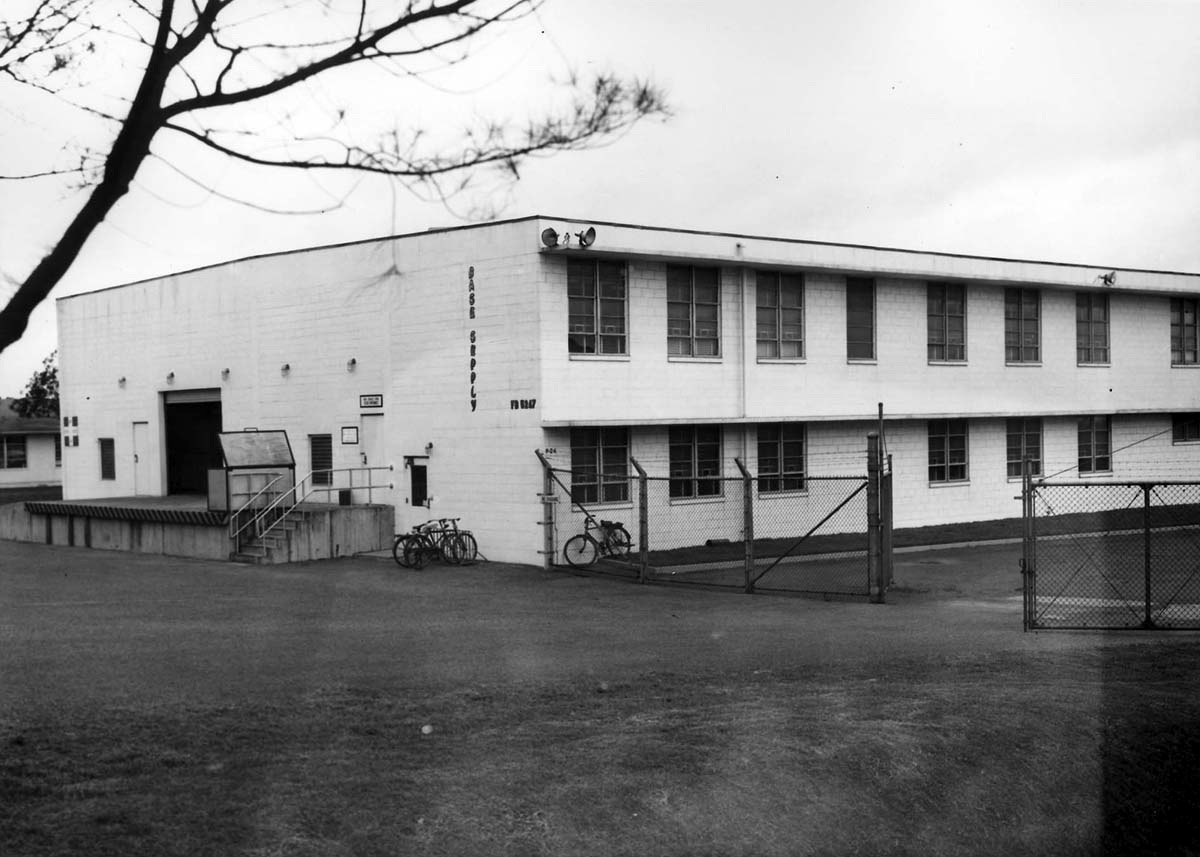
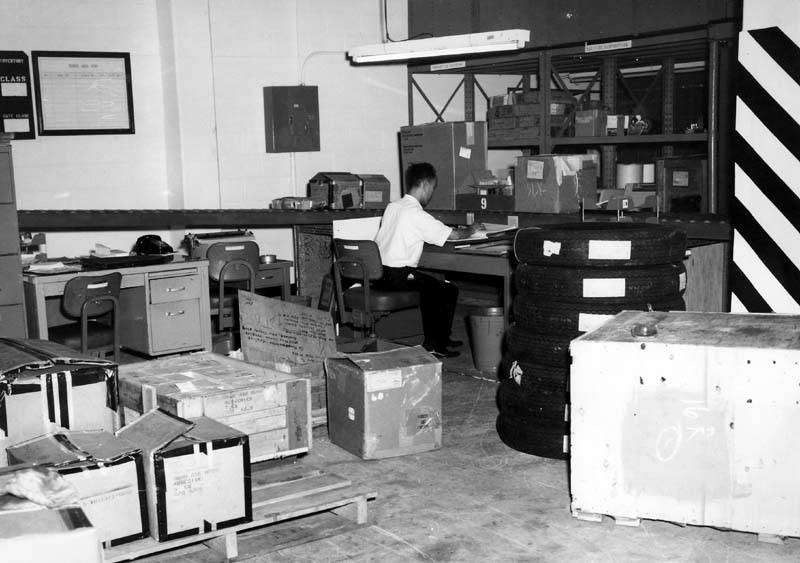
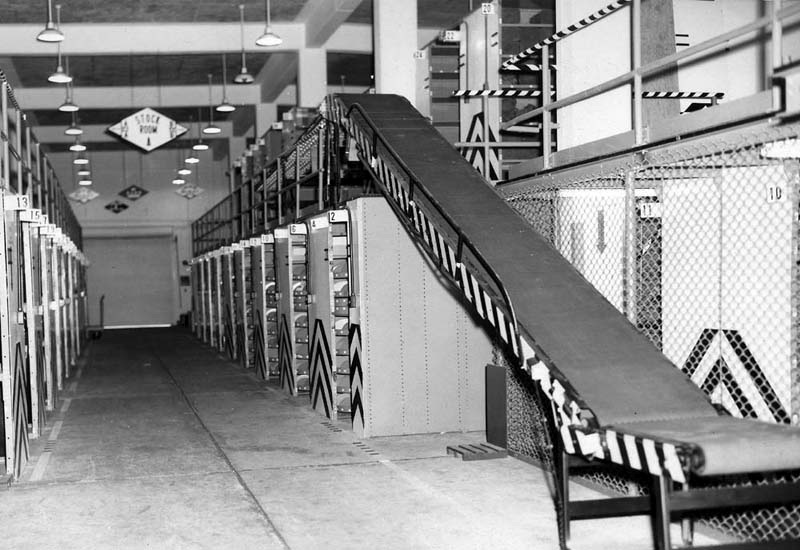
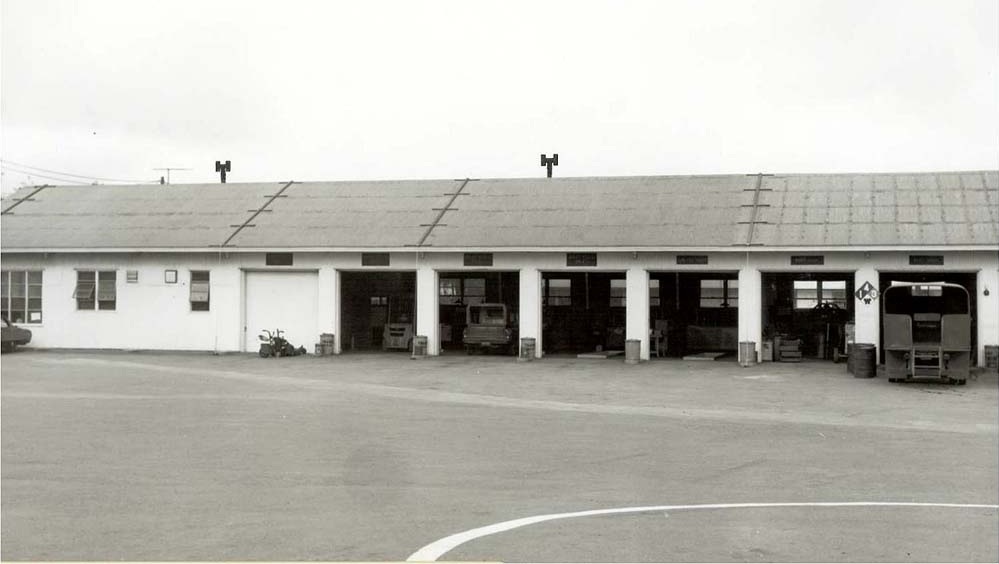
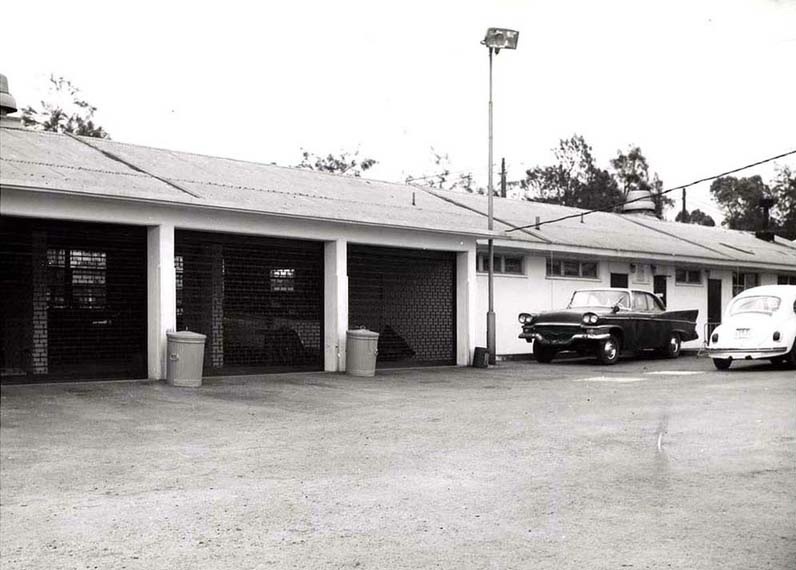
(1.) May 1969 photo of the of the base Supply Warehouse and Electronics Hobby Shop on the far left (see aerial photo above).
(2. & 3.) May 1969 interior shots of the base Supply Warehouse. The Supply Warehouse, completed in 1965, and the Operations Center, completed in 1964, were the first permanent concrete buildings on base.
(4.) May 1969 shot of the Vehicle Maintenance building at the base Motor Pool, which was located between the Supply Warehouse and Fire Department.
(5.) May 1969 of the Auto Hobby Shop located at the base Motor Pool.
Note: For 1960s construction photos of the base Supply Warehouse and Operations Center buildings: (Click Here) Shu Linkou Air Station: 1960-1969.

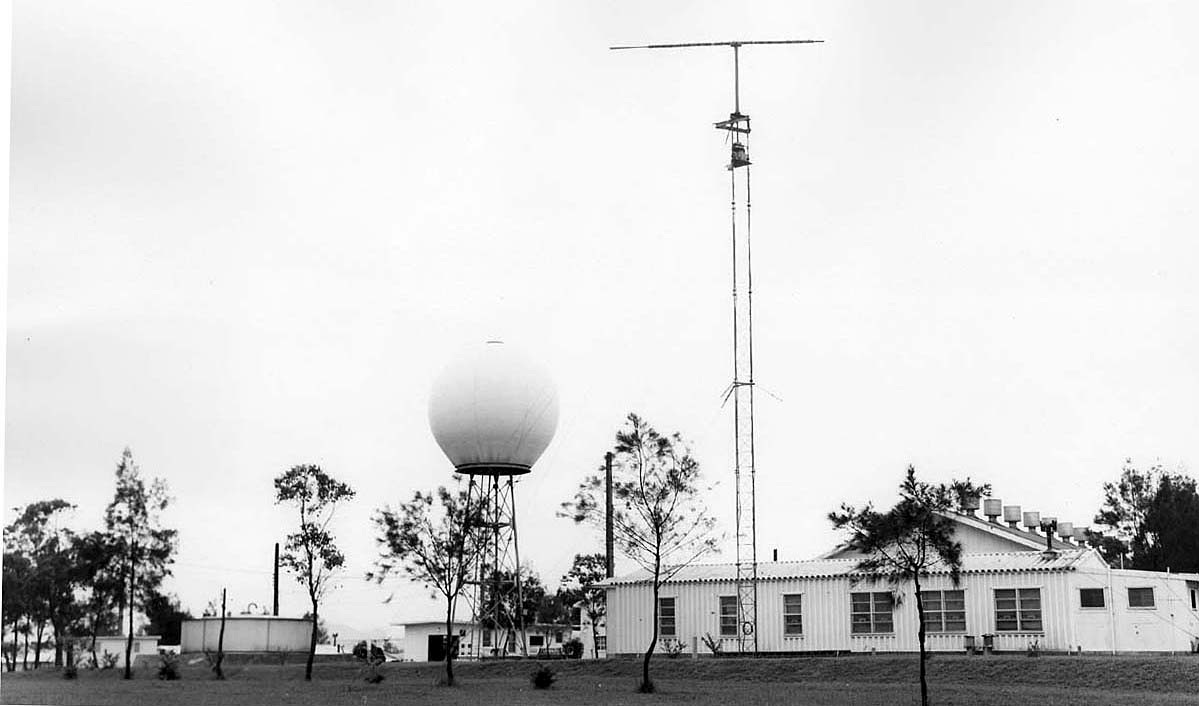
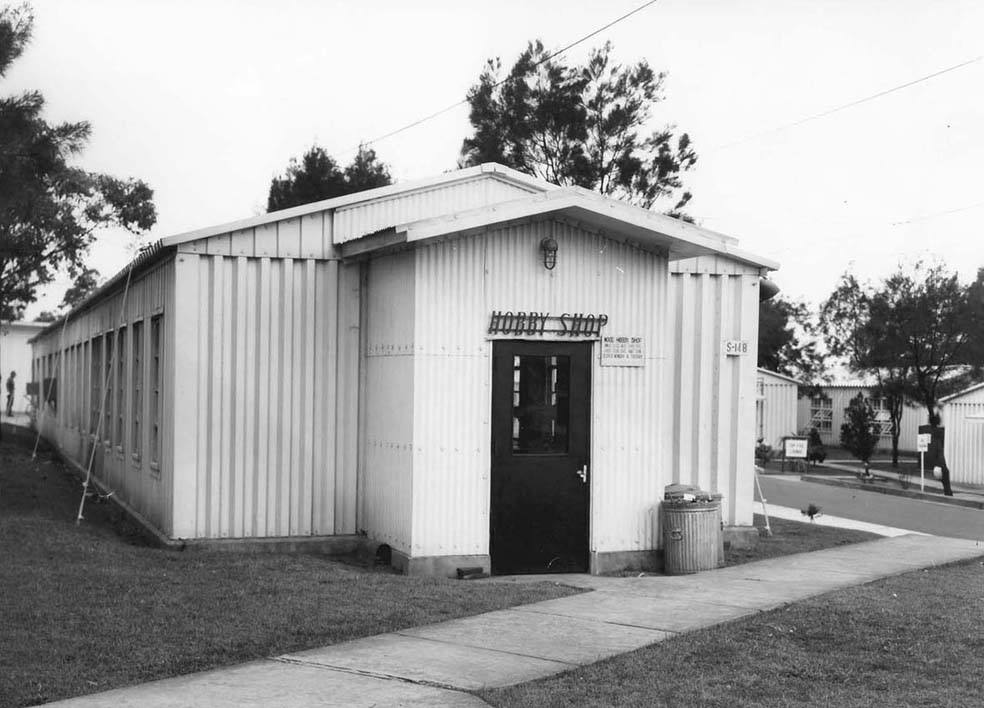
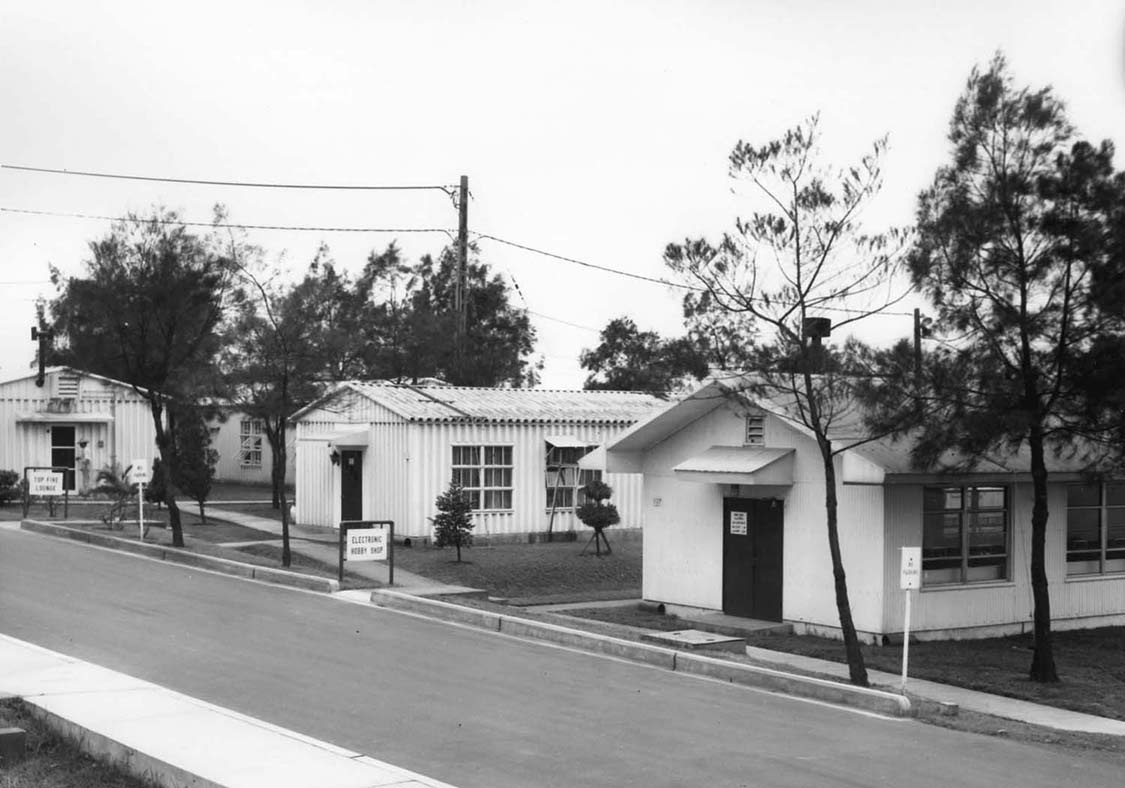
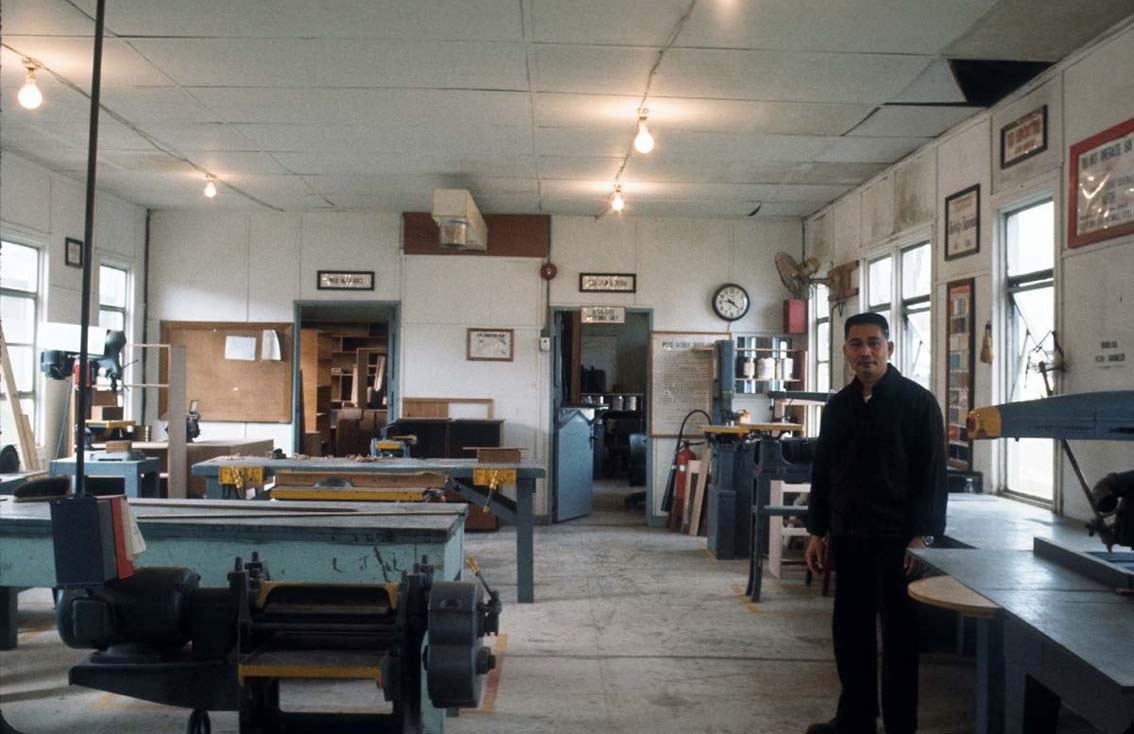
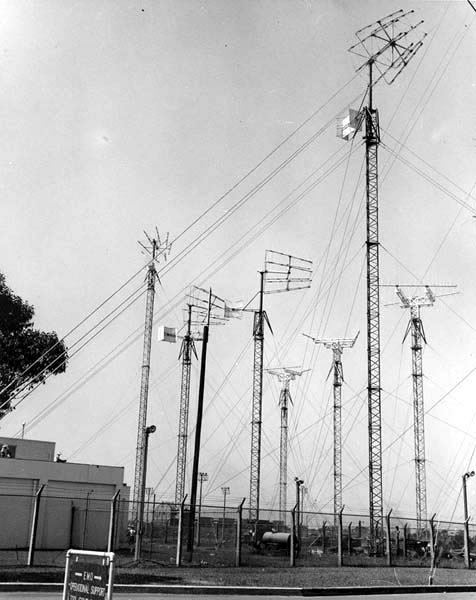
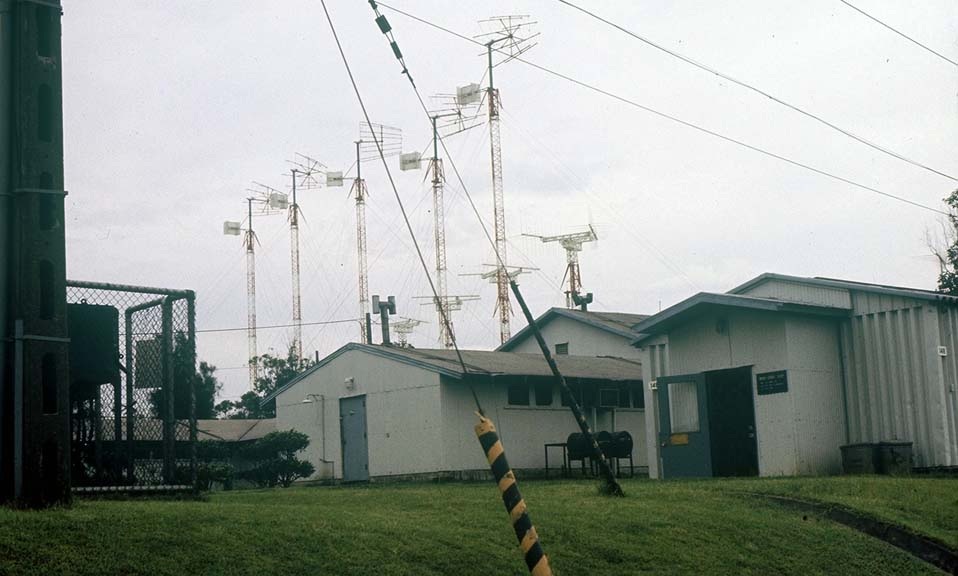 (1.) 1970 shot of Dave "Doink" Vandierdonck on the 5-hole par 3, "Pitch and Putt" Golf Course behind the Operations Center (see aerial photo above left). Shown is construction behind the Ops Center (far right).
(1.) 1970 shot of Dave "Doink" Vandierdonck on the 5-hole par 3, "Pitch and Putt" Golf Course behind the Operations Center (see aerial photo above left). Shown is construction behind the Ops Center (far right).
(2.) May 1969 shot of the white ELINT bubble (removed in 1970) adjacent to the golf course (foreground) and the rear of the small Antenna Maintenance building to its right. Civil Engineering (bldg. 145) is in the background. Picnic Pavilion is off to the left, Ops Center to the right.
(3.) May 1969 shot of the Wood Hobby Shop and the Electronic Hobby Shop (far right) across the street. Other hobby shops on base included auto (photo above), photo, ceramics, and lapidary.
(4.) May 1969 shot of the Electronic Hobby Shop (second bldg from right) and Top Five Lounge to its left. The Wood Hobby Shop is off to the left across the street. The small Top Five Lounge (E-5s and above) had a small full-service bar with stools along the left side as you entered, 3-4 tables and jukebox on the right, and a kitchen in the back for sandwiches, subs, burgers, and fries.
(5.) Wood Hobby Shop 1970. (Photo on Right-Click to Enlarge) 1973 street view of the Wood Hobby Shop (far right) looking toward the Operations Center.
(Left Photo) Circa 1973 shot of the antenna field looking toward the right rear of the Ops Center (far left). The sign in the left foreground reads: "EMO Operational Support" building.
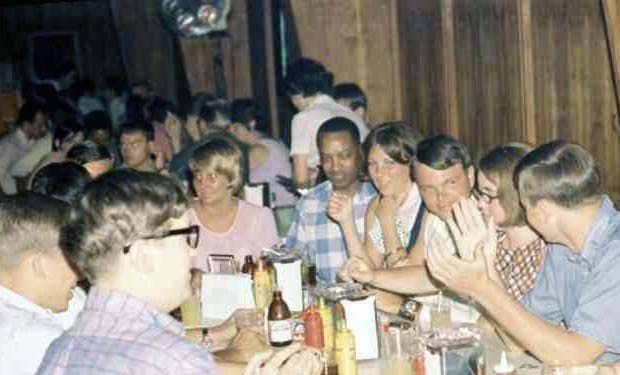
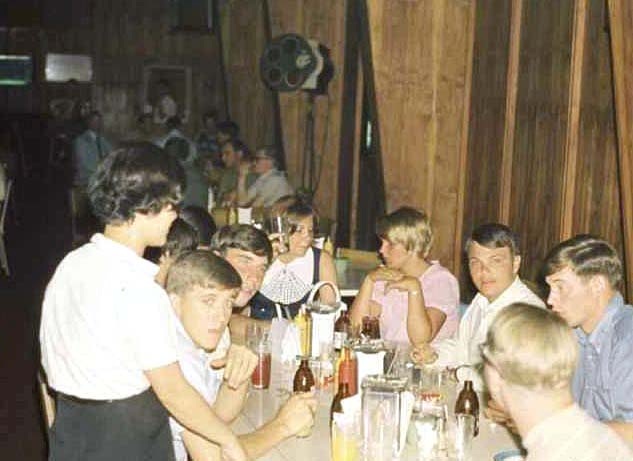
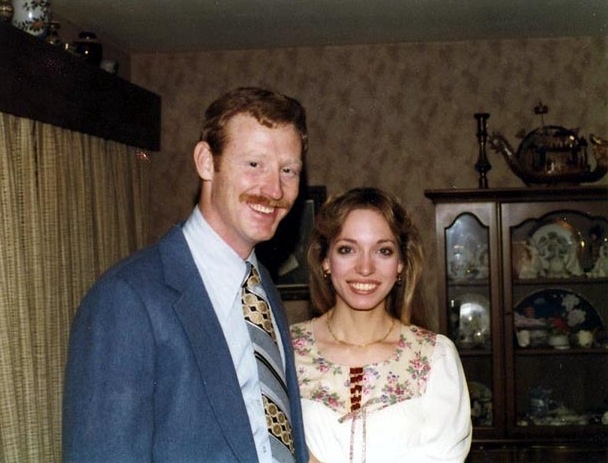
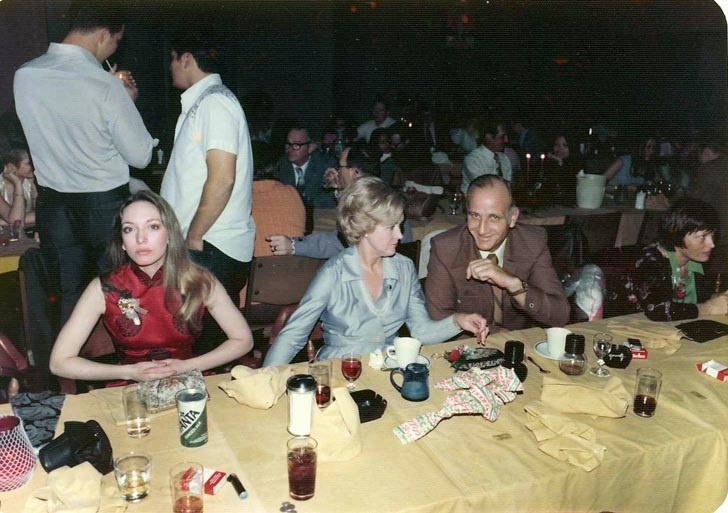
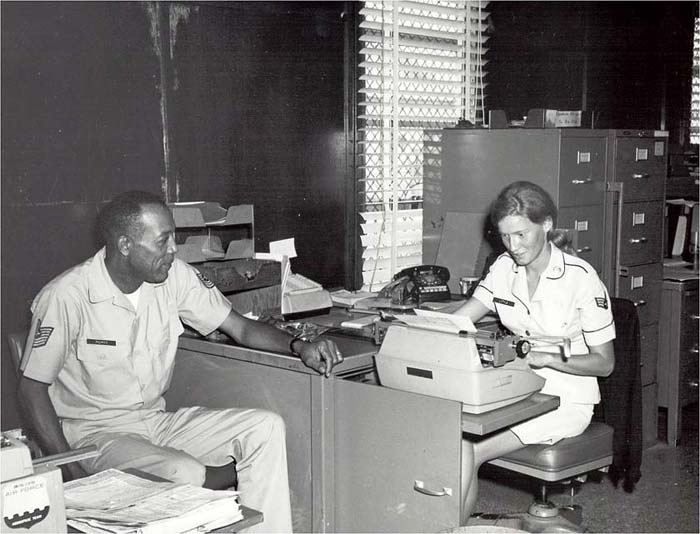
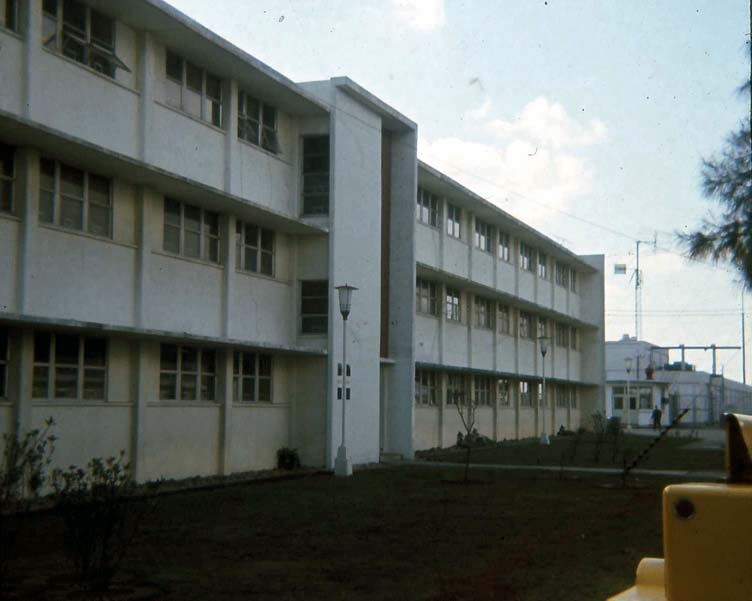 (1. & 2.) Three Linkou WAF's being entertained by Navy "Squids" and Baker Flighters (club regulars) at the Linkou Club on the Hill (1970 photo).
(1. & 2.) Three Linkou WAF's being entertained by Navy "Squids" and Baker Flighters (club regulars) at the Linkou Club on the Hill (1970 photo).
(3.) 1977 shot of Catherine "Katie" Jarvis (1976-77) and her husband Roger Jarvis (1975-77). Catherine, a USAFSS SSgt. 202X0 Communications Analyst, worked in the Linkou Ops Center "Day Shop". Roger, a USAF civilian employee (GS-11), was the Linkou MWR Chief (Recreation Services).
(4.) 1976 Linkou Christmas party. (L-R) Catherine Jarvis (1976-77), and Mrs. and Colonel James Kater, 6987th Group Commander (1974/75-Mar 77).
(5,) May 1969 shot of an unidentified MSgt. and WAF Sgt. in unclassified administrative support roles at Linkou.
(Left Photo) Side view of the WAF (Women in the Air Force) barracks in 1970 with the Ops Center and Compound in the background. Shown is the barracks' center entrance to the interior stairwell. The WAFs were housed on the second floor with a locked full-height, chain-link gate in the interior stairwell between floors for security. Base support personnel were housed on the first and third floors. The first floor was also utilized for temporary quarters. This 1970 shot was taken in front of the Accounting and Finance Building (see photos above), which is just off to the right of the photo.
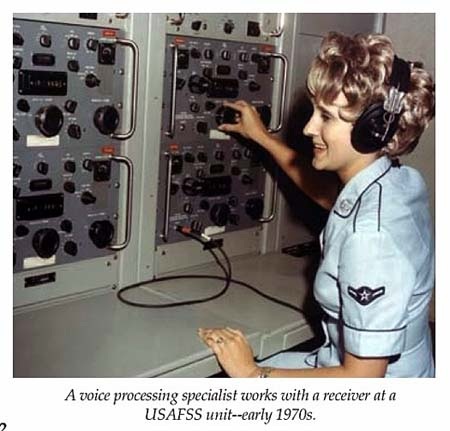
"In October of 1965, Taiwan's first WAF, A2C Judy Shepard, reported into Shulinkou with her husband A2C Tom Shepard. She was not only the first WAF to be assigned to Taiwan, but also the first within Security Service to be assigned to the Pacific Area. During 1967 in conjunction with the USAF program to increase the use of Women in the Air Force (WAF) (Click Here for website), the USAFSS assigned women to several units in the U.S. and overseas including Shulinkou AS in unclassified base support roles. This was the first time enlisted women were assigned to USAFSS operational sites overseas. (source: "1948-2009, A Continuing Legacy", USAF ISR Agency.)
In October 1968, Col. Jeanne Holm (later Major General), who was the director of Women in the Air Force (WAF), inspected Shulinkou in preparation for the first assignment of unaccompanied enlisted WAF in November 1968." (source: Shulinkou Devil Dog newspaper, Feb. 23, 1977 edit.)
provided by Katie Jarvis ('76-'77)
(Photo on Right) WAF Linguist (203MB), USAFSS, circa 1972.
(NOTE): WAF officers started working inside the Operations Center in a classified capacity at Linkou in 1971. In 1971, 2nd Lt. Darby Warf, Charlie Flight commander, became the first WAF Flight Commander in the Linkou Ops Center. In mid 1972, Dawg Flight's Laura Prendable (292X1) became the first enlisted WAF to be assigned to a flight and work in the Linkou Ops Center.
Judy Tabler (Dawg Flight 203: 1974-75): "I went to DLI Monterey 1973-74. I was one of the first female Chinese linguists (203MB) at Shu LinKou, not the first. I was in the first class to include women, and several of us arrived in Taiwan at the same time. Being among the first women didn't make us popular on the job site at first. I remember particularly, Dawg Flight complaining that they wouldn't be able to drop their pants on mids anymore! They also seemed to go out of their way to use "salty" language in front of us.
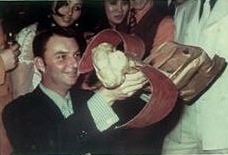 Ray "Buddy Ray" Tallman (Dawg Flight 292X1: 1971-76) recalls the arrival of the first WAFs on Dawg Flight: "Many of the unique things Dawg Flight had when I arrived in late '71, such as the monthly Flying 'D' Award (...aka the Flying 'Weenie' Award), were eliminated or toned down when women began arriving on Flight around June '72. The Flying 'D' Award (Dec 1971 photo on right) was the first thing to go. Even the "Mid-Rag" was not immune to 'management' editing.
Ray "Buddy Ray" Tallman (Dawg Flight 292X1: 1971-76) recalls the arrival of the first WAFs on Dawg Flight: "Many of the unique things Dawg Flight had when I arrived in late '71, such as the monthly Flying 'D' Award (...aka the Flying 'Weenie' Award), were eliminated or toned down when women began arriving on Flight around June '72. The Flying 'D' Award (Dec 1971 photo on right) was the first thing to go. Even the "Mid-Rag" was not immune to 'management' editing.
The first three WAFs to arrive on Dawg Flight were X1's (Airman Laura Prendable was the first). One WAF went to 'Wheatgerm's' aisle and the other two were assigned to 'Uncle Woody's' aisle. Overall, from an all male environment prior to '72 to a coed one from '73 onward, it was guite a change that took some of the guys a long time to get used to." [17 June 2009]
I definitely learned to be unshockable, a good trick for a naive young girl from Oklahoma which has served me well throughout my life! I also remember my Flight Commander telling me he didn't think I could type with long fingernails (I could). After we'd been there for a while though, things calmed down and I made lots of friends among the guys. I do believe I was the first female to graduate from the rack to transcribing. The backhand compliment I remember was, 'I wasn't like other women...I was good'...!" [2012] courtesy of "6987thAlumniAssociation.org"
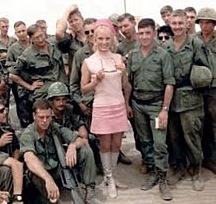
 Bucking "strict" orders and USAFSS regulations the Dawgs regularly tuned in Armed Forces Network Taiwan (AFNT) broadcast from Taipei on their bottom R-390 receiver (Click Here) for the latest '70s sounds from the "World" while "searching" for their "man" on their top receiver. "THE PANTOM" also secretly "piped in" AFNT tunes to the Dawgs Flight 292X1s at their racks (Photo on Right) from his 202 ID/DF control panel...much to the great dismay of "management".
Bucking "strict" orders and USAFSS regulations the Dawgs regularly tuned in Armed Forces Network Taiwan (AFNT) broadcast from Taipei on their bottom R-390 receiver (Click Here) for the latest '70s sounds from the "World" while "searching" for their "man" on their top receiver. "THE PANTOM" also secretly "piped in" AFNT tunes to the Dawgs Flight 292X1s at their racks (Photo on Right) from his 202 ID/DF control panel...much to the great dismay of "management".
The Chris Noel radio show: "In 1965 after visiting wounded Vietnam veterans in a hospital, the sexy new starlet became a DJ for the Armed Forces Radio and Television Services (AFRTS-Click Here). Her daily radio show 'A Date with Chris' was an instant hit." (Click Here for Chris Noel's website.)
"A Date with Chris" (Click Here for "YouTube" video): 1967 Chris Noel radio show. Top 40 songs of the day and Vietnam film clips.
(Left Photo) Chris Noel in Vietnam circa 1969.